

Mollusks from Pliocene and Pleistocene seep deposits in Leyte, Philippines
STEFFEN KIEL, YOLANDA M. AGUILAR, and TOMOKI KASE
Kiel, S., Aguilar, Y.M., and Kase, T. 2020. Mollusks from Pliocene and Pleistocene seep deposits in Leyte, Philippines. Acta Palaeontologica Polonica 65 (3): 589–627.
We report 44 mollusk species from four Pliocene to Pleistocene seep deposits in Leyte Island, Philippines. The bivalves are represented by 30 species, of which eleven are new (Conchocele majimai, Conchocele visayaensis, Channelaxinus antipoloensis, Dulcina liogliogensis, Dulcina magoi, Elliptiolucina fernandoi, Lucinoma canudai, Lucinoma velosoi, Lucinoma tinagoensis, Lucinoma kosatorea, Archivesica pastori), six are extant species known from the Philippines and surrounding waters (Meganodontia acetabulum, Lucinoma dulcinea, Lucinoma aff. kastoroae, Vesicomya margotae, “Pliocardia” ticaonica, “Pliocardia” indica), and five are extant species known from Japanese waters (Bathymodiolus securiformis, Divalucina soyoae, Archivesica kawamurai, Pliocardia kuroshimana, Elliptiolucina ingens). Remarkable about those latter species is that only a single one of them occurs as fossil in Japan, despite Japan’s rich fossil record of seep communities. This together with the large number of new species with close relatives in Japan suggests that at least part of the modern Japanese vent and seep fauna originated in Philippine waters. More than one third (twelve) of the bivalve species reported here belong to the family Lucinidae, which is also very species-rich in shallow waters around the Philippines. Four new gastropods are described: Margarites hayashii, Vetulonia philippinensis, Cataegis ramosi, and Provanna azurini.
Key words: Gastropoda, Bivalvia, chemosymbiosis, Neogene, Quaternary, Indo-Pacific Ocean.
Steffen Kiel [steffen.kiel@nrm.se], Swedish Museum of Natural History, Department of Palaeobiology, Box 50007, 10405 Stockholm, Sweden.
Yolanda M. Aguilar [yolanda.maac@yahoo.com], Mines and Geosciences Bureau, Marine Geological Survey Division, Quezon City, Philippines.
Tomoki Kase [neritopsis@gmail.com], National Museum of Nature and Science, Department of Geology and Paleontology, Tsukuba, Ibaraki 305-0005, Japan.
Received 7 April 2020, accepted 10 June 2020, available online 28 August 2020.
Copyright © 2020 S. Kiel et al. This is an open-access article distributed under the terms of the Creative Commons Attribution License (for details please see http://creativecommons.org/licenses/by/4.0/), which permits unrestricted use, distribution, and reproduction in any medium, provided the original author and source are credited.
Introduction
Deep-water methane-seep faunas have a decent Cenozoic fossil record (Majima et al. 2005; Campbell 2006; Kiel 2010b) providing insights into the paleoecology and evolutionary history of these ecosystems (Campbell and Bottjer 1995; Amano and Jenkins 2007; Amano et al. 2010; Kiel 2010a, 2015; Kiel et al. 2016). Seep fossils of Plio-Pleistocene age, however, are relatively rare, probably because there has not been enough time for their uplift (Oppo et al. 2020). A few occurrences of chemosymbiotic bivalves are known from Plio-Pleistocene strata along the American Pacific coast and from Taiwan (Olsson 1942; Squires 1991; Campbell 1992; Wang et al. 2006), the late Pliocene Stirone river seep complex in northern Italy has a diverse fauna of around ten mollusk species (Cau et al. 2015; Kiel and Taviani 2018), and the richest Plio-Pleistocene record is that of Japan, with around 15 mollusk species (Majima et al. 2005; Amano et al. 2019).
A few Plio-Pleistocene seep deposits are known from the Philippines (Majima et al. 2007, 2010) but their fauna has never been described in detail, save for one large species of the vesicomyid genus Wareniconcha (Kase et al. 2019). The Philippines are part of the Indo-Australian Archipelago biodiversity hotspot and hence play an important role in generating biodiversity in the Indo-Pacific region (Ellison et al. 1999; Bellwood and Hughes 2001; Jablonski et al. 2006; Renema et al. 2008). Indeed, the species-rich chemosymbiotic bivalve family Lucinidae appears to have its center of biodiversity in the Philippines (Taylor and Glover 2006; Cosel and Bouchet 2008; Taylor et al. 2014; Glover and Taylor 2016). The Philippines might therefore also be significant for the diversity of deep-water methane-seep faunas. Here we provide a detailed taxonomic account on the mollusk fauna of these seep deposits, which includes a remarkably high diversity of lucinid bivalves.
Institutional abbreviations.—NMP, National Museum, Manila, Philippines; NMNS PM, National Museum of Nature and Science, Tsukuba, Japan; USNM, Smithsonian Natural History Museum, Washington, DC, USA.
Other abbreviations.—H, height; L, length; RV, right valve; LV, left valve; W, width.
Nomenclatural acts.—This published work and the nomenclatural acts it contains, have been registered in ZooBank: urn:lsid:zoobank.org:pub:3B7C70AD-CC73-44D5-921E-B1BA0503FC29
Material and methods
The specimens reported here were collected from four localities on the west coast of the northwestern tip of Leyte Island, Philippines (Fig. 1) (Majima et al. 2007, 2010). Deep-water strata of the Visayan back-arc Basin crop out in this area and are mapped as Bata Shale (Corby et al. 1951) or Bata Formation (Porth et al. 1989). Due to submarine slumping during the deposition and the extensive reworking of the micro- and nannofossils, the beds including the seep fauna described here are difficult to date. Ongoing stratigraphic and micropaleontologic work suggests that of the major four sampled localities, the seep deposits at Liog-Liog Point is of late Pliocene age, while the others are of early Pleistocene age.
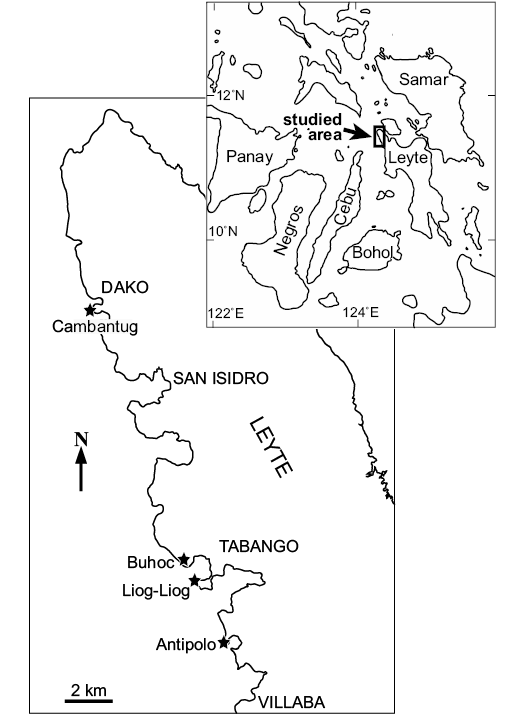
Fig. 1. Maps showing the locations of the four studied localities in the northwestern tip of Leyte Island, Philippines; Liog-Liog Point is of late Pliocene age, Antipolo Point, Buhoc Point, and Cambantug Point are of early Pleistocene age.
Liog-Liog Point.—This site has been described in detail before (Kase et al. 2019). At least four very large calcareous concretionary blocks are scattered in the property of Douglas Pastor at Liog-Liog Point between Tabango and Campopo Bays (11°17’37.7”N, 124°21’57.5”E). The blocks are densely packed with Archivesica pastori sp. nov. and Conchocele majimai sp. nov., and are most probably derived from the semi-consolidated mudstone horizon well below the Pliocene–Pleistocene boundary, as indicated by microfossil analyses (Kase et al. 2019). One of the very large blocks was extensively sampled and this block is meant when we refer to Liog-Liog Point as type locality; however, a few specimens were also collected from smaller, scattered blocks.
Buhoc Point.—This site is located south of Buhoc Point in Tabango (11°18’49”N, 124°20’39”E; Loc. 2 in Majima et al. 2007). The beds exposed at this site consist of semi-consolidated, tuffaceous, fine-grained sandstone. Huge float concretions derived from the sandstone are scattered on the intertidal platform and are often densely packed with articulated lucinid bivalves. Our microfossil analyses were not successful to date these beds in detail. We consider the beds as being of Pleistocene age because Majima et al. (2007) correlated the beds to the uppermost part of the Bata Formation exposed on the intertidal shore at the tip of Liog-Liog Point, which include the planktonic foraminifer Globorotalia truncatulinoides diagnostic for the Pleistocene.
Antipolo Point.—This site is Loc. 7 (11°15’28”N, 124°22’55”E) in Majima et al. (2007). Variable-sized and complex concretions resulting from the precipitation of authigenic carbonate around burrows cover the beach and sea cliff at Antipolo Point, and contain a swarm of articulated shells of Lucinoma spp. and Meganodontia acetabulum. The matrix surrounding these concretions consists of semi-consolidated and unconsolidated muddy sandstone that also yields chemosynthetic bivalves as well as normal deep-water mollusks. The beds in this site have been definitely dated as Pleistocene by planktonic foraminifer and nannofossil analyses.
Cambantug Point.—This site has been described in detail by Majima et al. (2007). It is located at the western corner of Cambantug Point (11°26’55.7”N, 124°18’18.1”E), where massive semi-consolidated mudstone beds are exposed on the beach and in the beach cliff. Abundant bivalves are found in several calcareous concretions of variable size and also in mudstone around the concretions. The bivalves are mostly articulated and densely packed, keeping their original life orientations. The dating of the mudstone beds remains somewhat questionable: nannofossils provided a middle Pliocene age (NN15), whereas planktonic foraminifers point to an early Pleistocene age. This might indicate reworking of the nannofossils and hence we consider the age of the calcareous concretions as early Pleistocene.
All measurements are given in mm rounded to the nearest first decimal place.
Systematic paleontology
Class Bivalvia Linnaeus, 1758
Family Mytilidae Rafinesque, 1815
Subfamily Bathymodiolinae Kenk and Wilson, 1985
Genus Bathymodiolus Kenk and Wilson, 1985
Type species: Bathymodiolus thermophilus Kenk and Wilson, 1985, by original designation; Recent, Galapagos Ridge.
Bathymodiolus securiformis Okutani, Fujikura, and Sasaki, 2004
Fig. 2A, B.
2004 Bathymodiolus securiformis sp. nov; Okutani et al. 2004: 105, figs. 4C, D, 7C, D, 8, 9.
2005 Bathymodiolus securiformis Okutani, Fujikura and Sasaki, 2004; Sasaki et al. 2005: 94, fig. 5E.
2019 Bathymodiolus securiformis Okutani, Fujikura and Sasaki, 2004; Kuo et al. 2019: 355, fig. 4.
Material.—Liog-Liog Point, Pliocene: five specimens, NMNS PM 28133, 28175, 28203–28205 (L = 118.8 mm, Fig. 2A, B), NMNS PM 28203, and four unnumbered specimens. Antipolo Point, Pleistocene: an isolated right valve, NMNS PM 28169 (L = 129.1 mm).
Remarks.—The Pliocene Philippine specimens reported here differ somewhat from the extant Bathymodiolus securiformis from the Okinawa Trough by having a slightly longer anterior portion of the shell. The genetically closest species to B. securiformis, B. tangaroa Cosel and Marshall, 2003, is less slender, and its subspecies B. tangaroa tuerkayi Cosel and Janssen, 2008 is broader on the posterior side (Cosel and Marshall 2003; Okutani et al. 2004; Cosel and Janssen 2008).
Stratigraphic and geographic range.—Pliocene: Leyte, Philippines. Recent: Okinawa Trough.
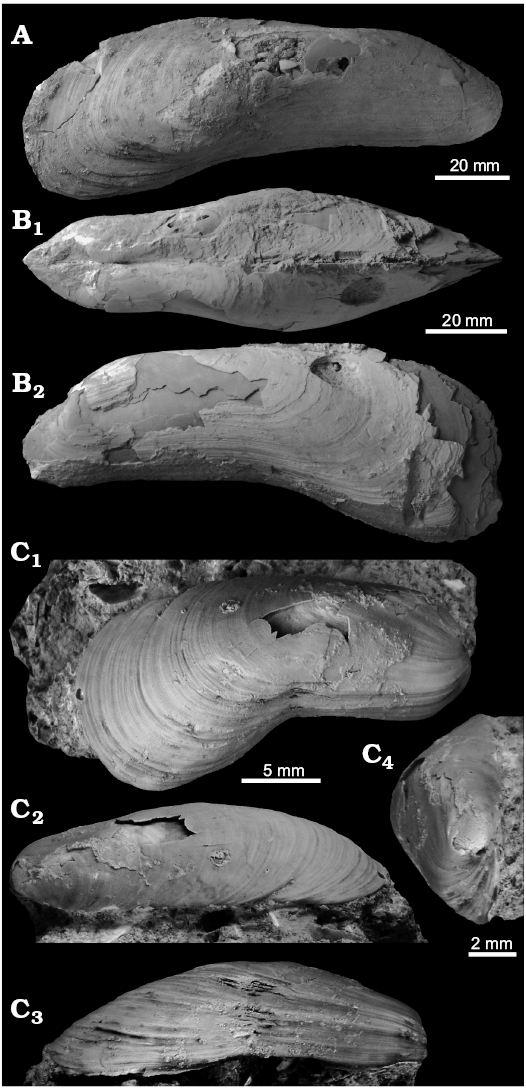
Fig. 2. Bathymodiolin bivalves from Pliocene (B, C, Liog-Liog Point) and Pleistocene (A, Antipolo Point) seep deposits in Leyte, Philippines. A, B. Bathymodiolus securiformis Okutani, Fujikura, and Sasaki, 2004. A. NMNS PM 28169, a right valve. B. NMNS PM 28202, an articulated specimen in dorsal view (B1), exterior of left valve (B2). C. The unidentified bathymodiolin, NMNS PM 28170, outside of right valve (C1), specimen in dorsal (C2), ventral (C3), and anterior (C4) views.
Unidentified bathymodiolin
Fig. 2C.
Material.—Liog-Liog Point, Pliocene: one right valve, NMNS PM 28170 (L = 25.6 mm).
Description.—Small modioliform shell, greatest inflation approximately at horizontal midline; low, subterminal umbo, long posterodorsal margin, narrow and almost evenly convex posterior margin, anterior margin narrowly rounded; shell surface with irregular growth lines.
Remarks.—The single available right valve experienced a shell injury about at its midline, resulting in a deformation that makes the identification of this specimen difficult. Bathymodiolus hirtus, B. japonicus and B. platifrons possess a similar low, subterminal umbo, but those species have a more drawn-out posterior margin that is acutely rounded posteroventrally (Hashimoto and Okutani 1994; Okutani et al. 2004; Sasaki et al. 2005). Bathymodiolus securiformis has a similar narrow posterior margin and long posterodorsal margin, but also a much more elongate anterior margin. Two taxa associated with wood and bones in the Westpacific Ocean are also similar: “ESU D” from the Philippines and Japan, and “Idas sp. SAL 4” from Vanuatu and Philippines (Lorion et al. 2010).
Family Thyasiridae Dall, 1900
Genus Conchocele Gabb, 1866
Type species: Thyasira bisecta Conrad, 1849, type by monotypy; Miocene, Astoria Formation, Oregon, USA.
Conchocele majimai sp. nov.
Fig. 3.
Zoobank LSID: urn:lsid:zoobank.org:act:5B70D6CF-1E10-454E-82EE-4E85D1834913
Etymology: In honour of Ryuichi Majima (Yokohama National University), who cooperated field work.
Type material: Holotype NMP-2159, an isolated left valve; paratype NMNS PM 28171, an isolated right valve.
Type locality: Liog-Liog Point, Leyte, Philippines.
Type horizon: Upper Pliocene part of the Bata Formation.
Material.—The type material and two unnumbered specimens from the type locality.
Dimensions (in mm).—NMP-2159, L = 72.0, H = 60.0; NMNS PM 28171, L = 68.0, H = 58.0.
Diagnosis.—Large Conchocele with slightly concave anterior margin; broad posterodorsal area with low median ridge, bordered by deep, slightly curved posterior sulcus causing slight indentation of posterior margin; ventral margin straight, broadly curving into posterior margin.
Description.—Large, well-inflated shells, W/H ratio of one valve 0.30–0.33, umbones terminal, blunt, prosogyrate; anterior margin long, slightly concave; anterodorsal area broad with blunt internal ridge starting at umbo, ending at 2/3 of length anterodorsal area; anterior half of ventral margin straight, then turning dorsally in broad curve until reaching posterior end of shell; dorsal margin evenly and slightly convex, transition to posterior margin marked by distinct corner; posterodorsal area broad, bordered by deep, sulcus that is curved on first half of shell, nearly straight on second half, and causes an indentation on the posterior shell margin; outer surface with fine, irregular growth lines.

Fig. 3. The thyasirid bivalve Conchocele majimai sp. nov. from the Pliocene Liog-Liog Point seep deposit in Leyte, Philippines. A. Paratype NMNS PM 28171, an isolated right valve; outer shell surface (A1), anterior side (A2), posterodorsal margin (A3). B. Holotype NMP-2159, an isolated left valve; posterodorsal margin (B1), anterior side (B2), outer shell surface (B3).
Remarks.—Conchocele majimai differs from Conchocele visayaensis sp. nov. described below by its almost straight posterior sulcus, the broader posterodorsal area, and its straight ventral margin. The extant Conchocele novaeguinensis Okutani, 2002 from northern Papua New Guinea differs from C. majimai by its strongly coiled umbo (Okutani 2002). The extant Conchocele ochotica (Krishtofovich, 1936) (= Thyasira disjuncta var. ochotica Krishtofovich, 1936) has a more distinctive (= deeper) posterior groove above the posterior ridge, and a narrower posterodorsal area than Conchocele majimai (Krishtofovich, 1936). Also extant North Pacific specimens illustrated as Conchocele bisecta or Conchocele disjuncta (Coan et al. 2000; Kamenev et al. 2001; Kharlamenko et al. 2016) have a narrower posterodorsal area than Conchocele majimai. A specimen illustrated as Conchocele sp. from Broken Water Bay in Papua New Guinea (Samadi et al. 2015: fig. 2F) has a more rounded ventral margin and a narrower posterodorsal area than Conchocele majimai. The Miocene holotype of Conchocele bisecta has a much more rounded outlined and a more acutely rounded anterior margin than both Conchocele majimai and Conchocele visayaensis described below.
Stratigraphic and geographic range.—Late Pliocene, Leyte, Philippines.
Conchocele visayaensis sp. nov.
Fig. 4.
Zoobank LSID: urn:lsid:zoobank.org:act:B519A43A-40C5-4D98-9DF6-24314E078AC6
Etymology: In reference to the Visaya Basin, the type region.
Type material: Holotype NMP-2160, an articulated specimen.
Type locality: Cambantug Point, Leyte, Philippines.
Type horizon: Lower Pleistocene part of the Bata Formation.
Material.—The holotype and 11 articulated specimens (in one lot: NMNS PM 28126).
Dimensions (in mm).—NMP-2160, L = 77.6, H = 66.4.
Diagnosis.—Large Conchocele with slightly concave anterior margin; posterodorsal area rather narrow, median ridge indistinct to absent, posterior sulcus curved, producing deep indent in posterior shell margin; ventral margin well rounded, transition to posterior margin indistinct.
Description.—Large, well-inflated shells, W/H ratio of single valve ~0.36, umbones terminal, blunt, prosogyrate; anterior margin long, slightly concave; anterodorsal area broad, heart-shaped, bordered by distinct ridge; posterodorsal area narrow, smooth, bordered by blunt sulcus and ridge that form deep indentation at posterior margin; ventral margin gently convex, ending posteriorly at posterior sulcus; outer surface with fine, irregular growth lines.

Fig. 4. The thyasirid bivalve Conchocele visayaensis sp. nov. from the Pleistocene Cambantug Point seep deposit at Leyte, Philippines, holotype NMP-2160, outer shell surface of right (A1) and left (A2) valves; anterior side (A3), posterodorsal margin (A4).
Remarks.—For differences to Conchocele majimai see above. Compared to Conchocele visayaensis, Conchocele sp. from Papua New Guinea (Samadi et al. 2015: fig. 2F) has a curved rather than angular transition from posterodorsal to posterior margin, and the posterior sulcus in a more dorsal position, resulting in a smaller posterodorsal area and in a broader and more curved posteroventral margin. The same applies to extant North Pacific shells typically identified as Conchocele bisecta (Coan et al. 2000; Kamenev et al. 2001; Kharlamenko et al. 2016). Shells identified as “Conchocele bisecta Conrad” dredged from Sagami Bay, Japan, in the collection of the National Museum of Nature and Sciences in Tsukuba (T. Haga coll.) are very similar, if not identical, to Conchocele visayaensis.
Stratigraphic and geographic range.—Early Pleistocene, Leyte, Philippines.
Genus Channelaxinus Valentich-Scott and Coan in Coan and Velentich-Scott, 2012
Type species: Channelaxinus oliveri >Valentich-Scott and Coan in Coan and Velentich-Scot, 2012 , by original designation; Recent, Bahía Santiago, Colima, México.
Remarks.—We follow the revised diagnosis for Channelaxinus provided by Oliver and Frey (2014: 466) and the provisional assignment of Thyasira excavata Dall, 1901, and Prothyasira adelaideana Iredale, 1930 to Channelaxinus (Oliver and Frey 2014; Oliver 2015).
Channelaxinus antipoloensis sp. nov.
Fig. 5.
Zoobank LSID: urn:lsid:zoobank.org:act:E4A68DB5-CBE8-4083-B52 D-3FB54D8B358D
Etymology: In reference to the type locality Antipolo Point.
Type material: Holotype NMNS PM 28177, an articulated specimen; paratypes: NMNS PM 28178, an isolated right valve, NMNS PM 28179, an articulated specimen from the type locality.
Type locality: Antipolo Point, Leyte, Philippines.
Type horizon: Lower Pleistocene part of the Bata Formation.
Material.—The type material and one lot including eight specimens (NMNS PM 28120) from the type locality.
Dimensions (in mm).—NMNS PM 28177, L = 43.0, H = 38.0, W = 25.3; NMNS PM 28178, L = 30.3, H = 24.0, W (single) = 8.5; NMNS PM 28179, L = 38.0, H = 30.0.
Diagnosis.—Shell of average size for genus; median ridges on shell surface developed as angulations rather than distinct ridges; lunule small for genus, comprising less than half of anterior shell margin; submarginal sulcus distinct but short.
Description.—Shell polygonal, umbones elevated, prosogyrate, rather blunt; short but distinct posterior submarginal sulcus; posterodorsal area of moderate height, rather short, bordered by distinct sulcus and sharp ridge; shell surface with two low angulations running from umbo to ventral shell margin; anterior margin straight to slightly concave; lunule deep, length slightly less than half of anterior margin; hinge plate narrow, edentulous; ligament nymph short.
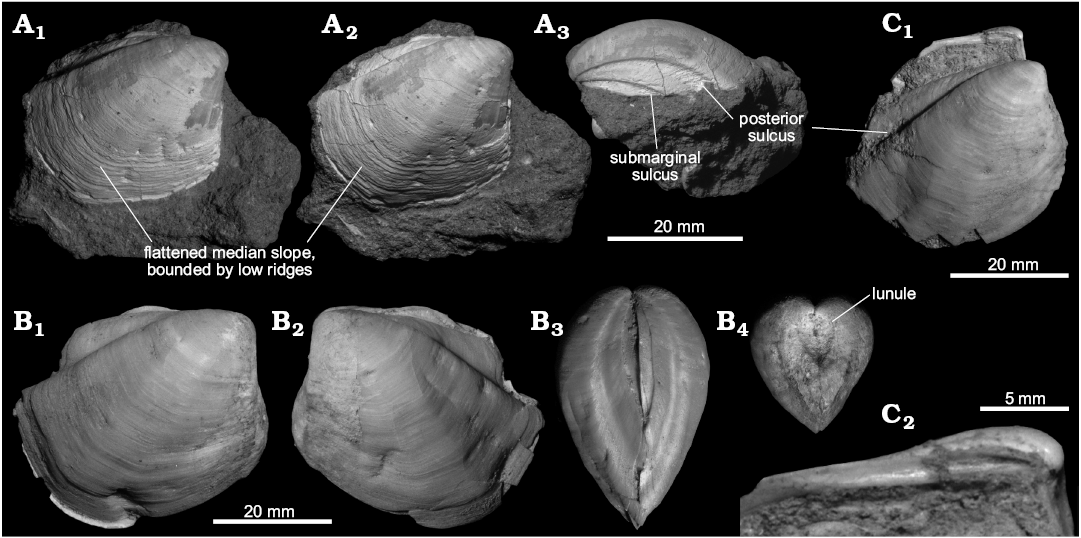
Fig. 5. The thyasirid bivalve Channelaxinus antipoloensis sp. nov. from the Pleistocene Antipolo Point seep deposit in Leyte, Philippines. A. Paratype NMNS PM 28178, disarticulated right valve embedded in rock matrix; exterior of shell with the light coming from two different angles, emphasizing the posterodorsal sulcus (A1) and the median angulation (A2), and view on dorsal margin (A3). B. Holotype NMNS PM 28177, articulated specimen; views on right (B1) and left (B2) valves, the dorsal margin (B3) and the anterior margin showing the lunule (B4). C. Paratype NMNS PM 28179, articulated specimen with displaced valves; view on exterior of right valve (C1), close-up on edentulous hinge of left valve (C2). Note the frequent repaired shell injuries on all specimens.
Remarks.—Channelaxinus antipoloensis sp. nov. is here placed in Channelaxinus based on its deeply impressed lunule and flattened median slope that is bounded by low ridges. With these two characters, C. antipoloensis clearly differs from members of Conchocele, a genus of large thyasirids that is often found at fossil seep deposits (see above). Ascetoaxinus Oliver and Frey, 2014, with its type species Ascetoaxinus quatsinoensis Oliver and Frey, 2014, has a similar overall shell shape, but C. antipoloensis differs from Ascetoaxinus by lacking the rounded projections that scallop the lunule edge in Ascetoaxinus, and by having a small lunule. Thyasira Lamarck, 1818 differs by having shells that are less angular and thinner, and the posterior and submarginal sulci of C. antipoloensis are deeper and sharper than in Thyasira.
The most similar extant species is Channelaxinus adelaideanus (Iredale, 1930); the original illustration is a sketch (Iredale 1930: pl. 63: 6, 7) and photos of the holotype were provided by Oliver (2015: figs. 3E, F). They show a specimen with a more pronounced median ridge compared to the median angulation of C. antipoloensis; also the less distinct radial ridge ventral to the median ridge is more pronounced in C. adelaideanus than in C. antipoloensis. Channelaxinus excavata (Dall, 1901) has a larger lunule and a more elongate submarginal sulcus than C. antipoloensis.
The only fossil so far assigned to Channelaxinus is Channelaxinus sp. from the middle Miocene (Langhian) Ca’ Cavalmagra seep deposit in northern Italy (Kiel and Taviani 2017: 450, fig. 5); the illustrated specimens differs slightly from C. antipoloensis by having a longer posterodorsal area, which is particularly well-seen in Kiel and Taviani (2017: fig. 5.4). The early Miocene Thyasira minoensis Itoigawa, 1960 from the Mizunami Group in central Honshu, Japan is also similar and might belong to Channelaxinus but appears to have a more defined median ridge (Itoigawa 1960: pl. 2: 1) compared to the median angulation C. antipoloensis. Another potential fossil Channelaxinus is the early Miocene (Altonian, ~late Burdigalian) Thyasira (Prothyasira) bartrumi Powell, 1935 from a deep-water faunule found near Auckland, New Zealand, which is smaller (L = 15 mm, H = 15 mm), and is more elongate and has a shorter anterior margin than C. antipoloensis (Powell 1935: 332, pl. 76: 5, 6).
Three species of similar overall shell shape, especially regarding shell outline, the deep and sharp posterior and submarginal sulci, and the flattened posterior slope, are the extant Conchocele koyamai Habe, 1981 from the Pacific shelf of Honshu, Japan, Conchocele compacta minor Omori, 1954 from Miocene deposits in Honshu, Japan, and Thyasira compacta Ishizaki, 1942 from the late Pleistocene of southern Taiwan (cf. Huang et al. 2006). However, Oliver and Frey (2014) noted that C. koyamai bears fine, radiating, punctate sculpture, unknown from Conchocele and Channelaxinus. Similar granular radial sculpture appears to be present also in C. c. minor (Omori 1954: pl. 7: 1–4) and T. compacta (Ishizaki 1942: 346, 349, figs. 1a–f, 2).
Stratigraphic and geographic range.—Early Pleistocene, Leyte, Philippines.
Family Lucinidae Fleming, 1828
Genus Meganodontia Bouchet and Cosel, 2004
Type species: Meganodontia acetabulum Bouchet and Cosel, 2004, by original designation; Recent, Taiwanese waters.
Meganodontia acetabulum Bouchet and Cosel, 2004
Fig. 6.
2004 Meganodontia acetabulum sp. nov.; Bouchet and Cosel 2004: 706, figs. 1–3.
Material.—Five specimens from the Pleistocene of Antipolo Point (NMNS PM 28107, 28110, 28112, 28166, 28167).
Dimensions (in mm).—NMNS PM 28167 (largest specimen), L = 132.2, H = 120.6.
Remarks.—There is some variation among the available specimens. Whereas specimens NMNS PM 28166 and 28167 are indistinguishable from the holotype of Meganodontia acetabulum, specimens NMNS PM 28110 and 28112 have a slightly more truncate anterodorsal margin, a slightly straighter posterodorsal margin, and a slightly more pointed beak than the holotype. However, we consider all specimens to belong to the extant Meganodontia acetabulum.
Stratigraphic and geographic range.—Early Pleistocene: Leyte, Philippines. Recent: Taiwanese waters.
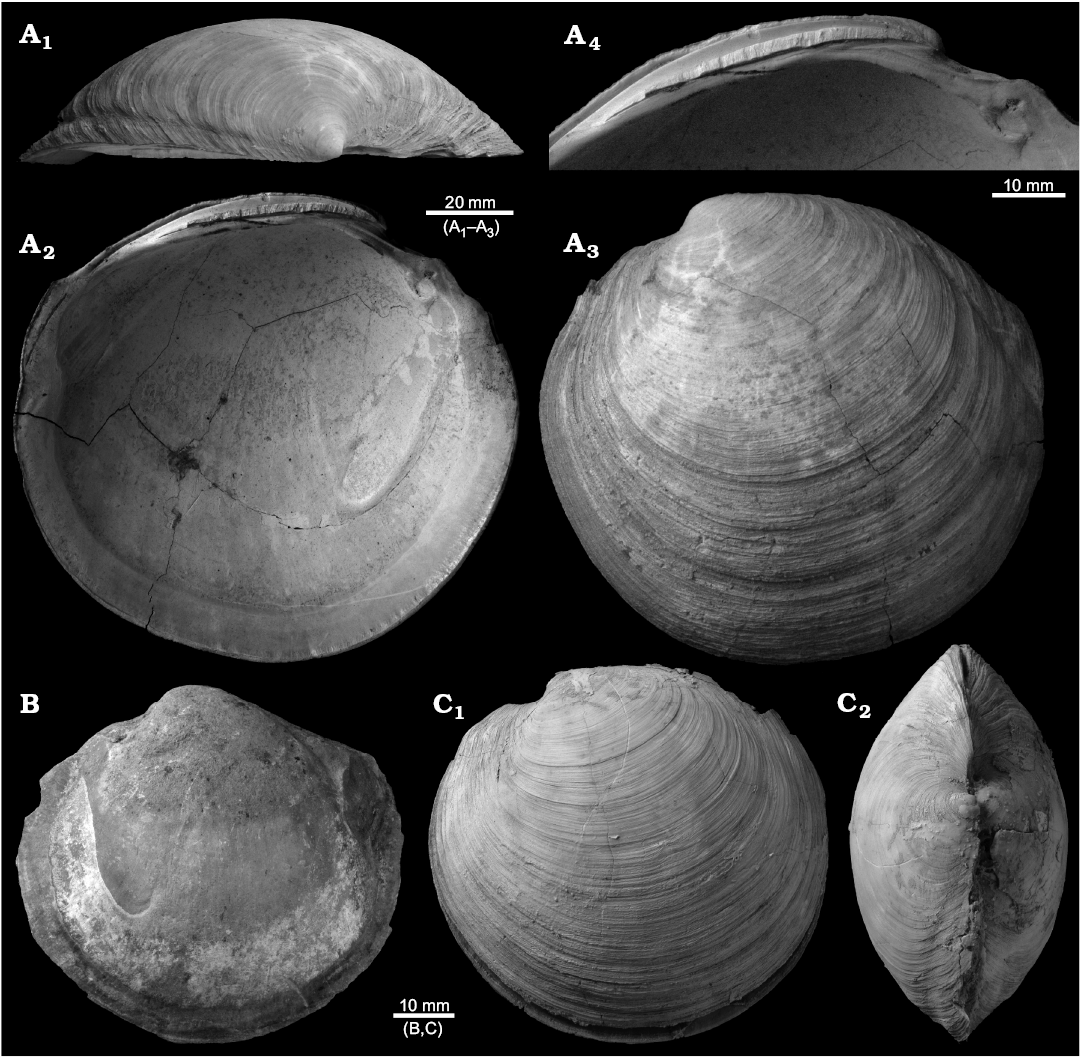
Fig. 6. The lucinid bivalve Meganodontia acetabulum Bouchet and Cosel, 2004 from the Pleistocene Antipolo Point seep deposit in Leyte, Philippines. A. NMNS PM 28166, disarticulated left valve; dorsal view (A1), inner (A2) and external (A3) shell surface, close-up on hinge (A4). B. NMNS PM 28107, internal mold; view on left valve showing the elongate adductor muscle scar. C. NMNS PM 28167, articulated specimen; view on outer shell surface of left valve (C1), dorsal view (C2).
Genus Dulcina Cosel and Bouchet, 2008
Type species: Dulcina guidoi Cosel and Bouchet, 2008, by original designation; Recent, central Philippines, 520–550 m.
Remarks.—Dulcina and Elliptiolucina discussed below differ mainly in two ways: Dulcina has a moderately long anterior adductor muscle scar, whereas in Elliptiolucina it is quite short; Dulcina has its posterior side acutely rounded, in contrast to the rounded and sometimes broad posterior side in Elliptiolucina.
Dulcina liogliogensis sp. nov.
Fig. 7.
Zoobank LSID: urn:lsid:zoobank.org:act:4637E9DC-6DE5-43B0-A3 D0-4AFC72FAEEC2
Etymology: In reference to the type locality at Liog-Liog Point.
Type material: Holotype NMP-2161, an articulated specimen; paratypes: NMNS PM 28127 (articulated), NMNS PM 28130 (left valve), NMNS PM 28131 (internal mold), NMNS PM 28136 (articulated), 28165 (internal mold).
Type locality: Liog-Liog Point, Leyte, Philippines.
Type horizon: Upper Pliocene part of the Bata Formation.
Material.—Late Pliocene of Liog-Liog Point: type material and many specimens including (NMNS PM 28127–28130, 28135–28137); early Pleistocene of Buhoc Point: two specimens (NMNS PM 28131, 28165); early Pleistocene of Amtipolo Point: four specimens (NMNS PM 28138–28141).
Dimensions (in mm).—NMP-2161, L = 69.5, H = 61.2; NMNS PM 28127, L = 64.4, H = 58.5; NMNS PM 28130, L = 63.7, H = 56.1; NMNS PM 28131, L = 64.3, H = 56.4; NMNS PM 28136, L = 65.6, H = 61.4; NMNS PM 28165, L = 52.0, H = 49.1.
Diagnosis.—Large, little inflated Dulcina with broad posterior margin; growth lines irregular, indistinct; hinge plate narrow with remnant of cardinal tooth in left valve.
Description.—Large, rather flat shells with oval outline, W/L ratio c. 0.38; umbones small, prosogyrate, elevated, positioned anteriorly at about 40% of total shell length; anterior margin broad, well-rounded; posterior side tapering on both dorsal and ventral sides, posterior margin truncate; escutcheon lanceolate; lunule small, elongate; anterodorsal area narrow, marked by distinct incision; posterodorsal area narrow, marked by shallow sulcus; external sculpture of irregular commarginal growth increments. Shell interior with faint radial striations; anterior adductor muscle scar elongate, reaching below horizontal midline of shell to ~60% total shell height, detached from pallial line for 3/5 its length; posterior adductor muscle scar pear-shaped, broad groove running from umbo to its anterior margin; hinge plate narrow, left valve with remnant of short cardinal 4b; length of ligament nymph ~70% of length of posterodorsal margin.
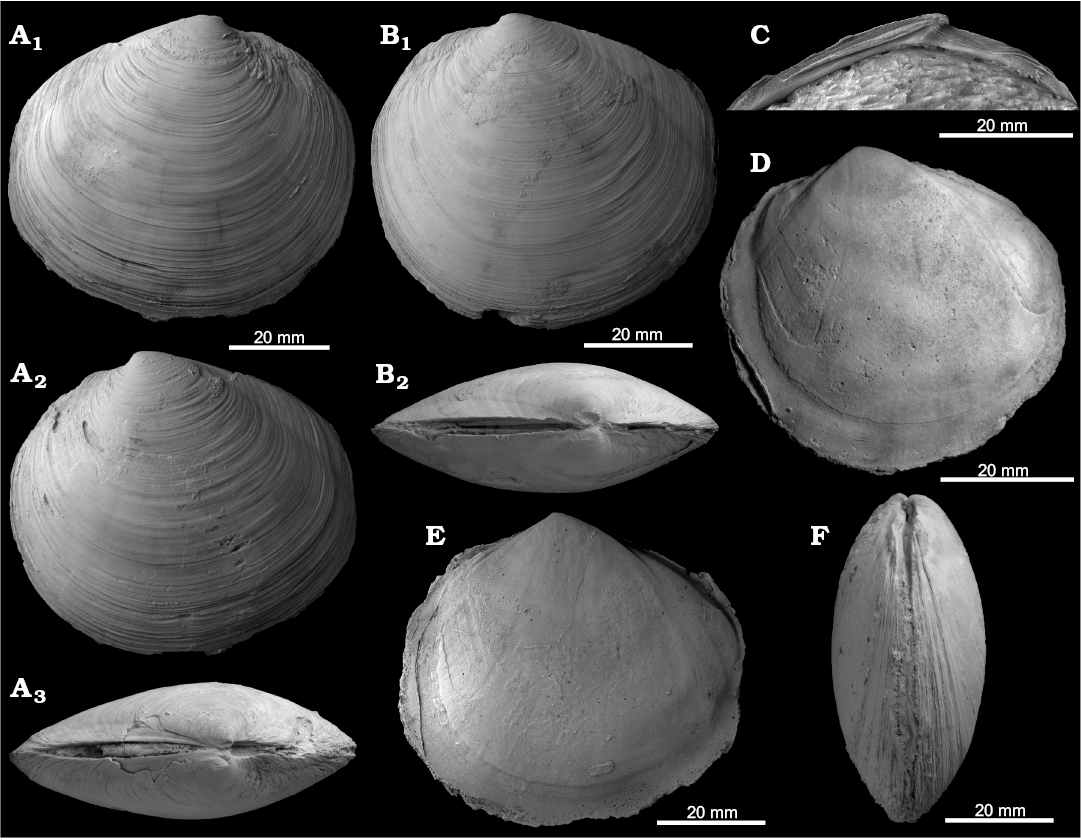
Fig. 7. The lucinid bivalve Dulcina liogliogensis sp. nov. from Pliocene (A–D, F, Liog-Liog Point) and Pleistocene (E, Buhoc Point) seep deposits in Leyte, Philippines. A. Holotype NMP-2161, articulated specimen; view on outer shell surface of right (A1) and left (A2) valves, dorsal view (A3). B. Paratype NMNS PM 28127, articulated specimen; view on outer shell surface of left valve (B1), dorsal view (B2). C. Paratype NMNS PM 28130, disarticulated left valve, close-up on hinge. D. Paratype NMNS PM 28165, internal mold, view on left valve showing anterior adductor muscle scar. E. NMNS PM 28131, internal mold of articulated specimen, view on left valve. F. NMNS PM 28136, articulated specimen, view on anterior external surface.
Remarks.—Dulcina liogliogensis sp. nov. is somewhat similar to D. guidoi but with broader posterior margin (not as acutely rounded as in guidoi); furthermore, Dulcina guidoi reaches 42 mm, whereas Dulcina liogliogensis reaches 60 mm, and the umbones of D. liogliogensis are in a more central position compared to D. guidoi, where they are displaced toward the anterior.
Stratigraphic and geographic range.—Late Pliocene, Leyte, Philippines.
Dulcina magoi sp. nov.
Fig. 8.
Zoobank LSID: urn:lsid:zoobank.org:act:10726DC8-540E-4521-A334-B1A80540EED4
Etymology: In honour of Wenceslao Mago (Mines and Geoscience Bureau, Quezon City, Philippines) for his invaluable help with collecting Philippine fossils.
Type material: Holotype NMP-2162, an articulated specimen; paratypes: NMNS PM 28132 (left valve), NMNS PM 28134 (articulated), NMNS PM 28148 (articulated specimen with little shell), and NMNS PM 28409 (internal mold); from type locality. Note that NMNS PM 28132, 28133, and 28148 are from a small (<1 m long) float concretion from the beach; NMNS PM 28134 and 28409 are from the very large block.
Type locality: Liog-Liog Point, Leyte, Philippines.
Type horizon: Upper Pliocene part of the Bata Formation.
Material.—The type material only.
Dimensions (in mm).—NMP-2162 L = 79.3, H = 77.7; NMNS PM 28132, H = 79.0; NMNS PM 28134, L = 70.2, H = 64.6, W = 31.4 (articulated); NMNS PM 28148, L = 80.1, H = 80.0.
Diagnosis.—Large, little inflated, subcircular shell; posterior ridge low; anterodorsal area with shallow, distinct groove; anterior adductor muscle scar elongate, reaching well below midline of shell, detached from pallial line for little more than half its length; hinge plate broad, edentulous.
Description.—Large, subcircular, little inflated shell; umbones small, prosogyrate, elevated, pointed, situated just anterior to vertical midline of shell; lunule narrow, elongate, escutcheon lanceolate; anterodorsal area bordered by low but distinct ridge, shallow but distinct groove in middle; anterior shell margin with distinct angulation at horizontal midline of shell; ventral and posterior margins well rounded; posterodorsal ridge and groove low, close to shell margin; external sculpture of indistinct growth lines. Interior of shell with numerous radial grooves; pallial line entire; anterior adductor muscle scar elongate, reaching almost 2/3 of entire shell height, detached from pallial line for just over half its length; posterior adductor muscle scar broad, pear-shaped; hinge plate moderately wide, edentulous, ligament nymph stretching the entire posterodorsal shell margin.
Remarks.—Dulcina magoi sp. nov. differs from the five species described by Cosel and Bouchet (2008) (D. guidoi, karubari, madagascarensis, minor, and musorstomi) by being larger (up to 80 mm length compared to 25–47 mm), and more circular, particular on the anterior side. In addition, D. minor and D. musorstomi differ by having distinct, sharp commarginal sculpture. From D. liogliogensis n. sp. described above it differs by being rounder (=not having an acutely rounded posterior side) and having a longer anterior adductor scar.
Stratigraphic and geographic range.—Late Pliocene, Leyte, Philippines.
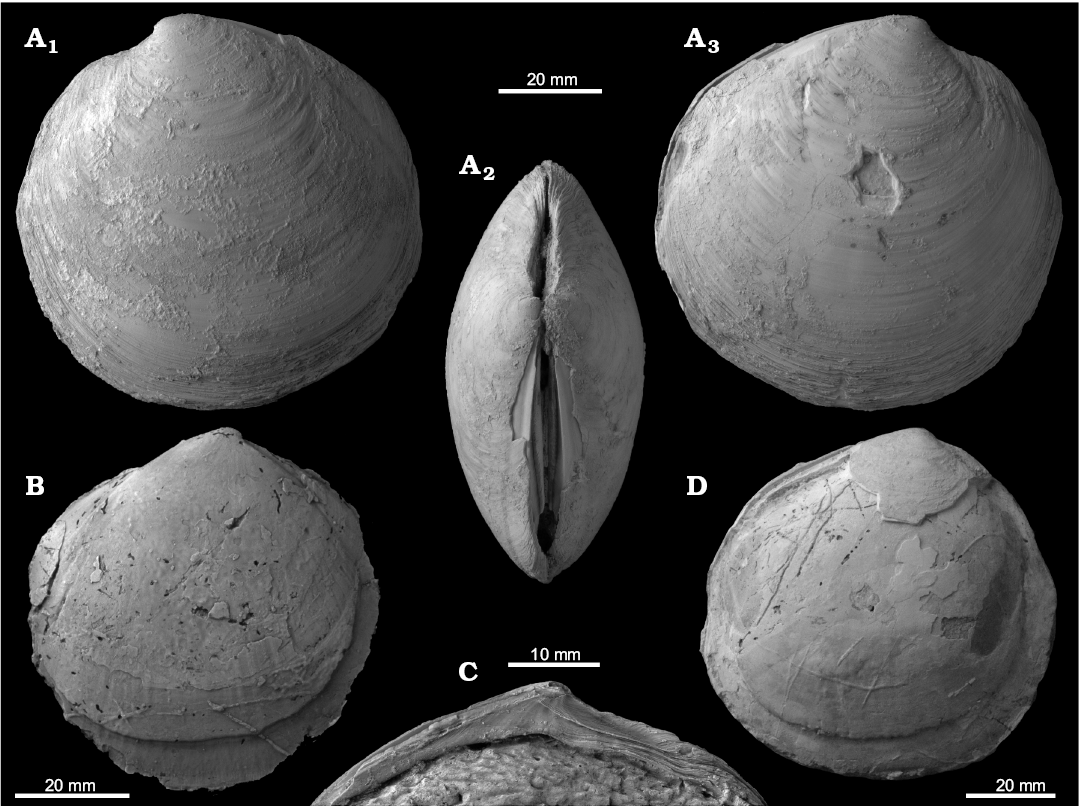
Fig. 8. The lucinid bivalve Dulcina magoi sp. nov. from Pliocene (A, C, D from a concretion found float at Liog-Liog Point) and Pleistocene (B, Buhoc Point) seep deposits in Leyte, Philippines. A. Holotype NMP-2162, articulated specimen; view on outer shell surface of left (A1) and right (A3) valves, dorsal view (A2). B. Paratype NMNS PM 28409, internal mold, view on right valve showing anterior adductor muscle scar. C. Paratype NMNS PM 28132, showing hinge area of left valve. D. Paratype NMNS PM, view of right valve showing anterior adductor muscle scar.
Genus Elliptiolucina Cosel and Bouchet, 2008
Type species: Elliptiolucina magnifica Cosel and Bouchet, 2008, by original designation; Recent, Philippines, 520–550 m depth.
Elliptiolucina ingens Okutani, 2011
Fig. 9.
2011 Elliptiolucina ingens sp. nov.; Okutani 2011: 116, figs. 1A, 2, 3.
Material.—Two specimens from the Pliocene of Liog-Liog Point: NMNS PM 28117, an isolated right valve; NMNS PM 28121, an isolated right valve.
Dimensions (in mm).—NMNS PM 28117, L = 91.0, H = 75.8; NMNS PM 28121, L = 92.4, H = 75.4.
Remarks.—The available specimens from Liog-Liog Point vary regarding the angle at which the anterior adductor muscle scar (aams) deviates from the pallial line. Whereas the aams deviates widely from it in specimen NMNS PM 28121 (Fig. 9C) as in the holotype of E. ingens, it is very close to the pallial line in specimen NMNS PM 28117 (Fig. 9B). Although the extant E. ingens is known only from the holotype and intraspecific variability cannot be assessed, for now we consider the observed differences in deviation of the aams as intraspecific variation.
Stratigraphic and geographic range.—Late Pliocene: Leyte, Philippines. Recent: East China Sea.

Fig. 9. The lucinid bivalve Elliptiolucina ingens Okutani, 2011 from the Pliocene Liog-Liog Point seep deposit in Leyte, Philippines. A. NMNS PM 28118, a right valve showing sculpture on outer surface (A1) and the hinge (A2, A3). B. NMNS PM 28117, a right valve, interior of right valve showing hinge and adductor muscle scars (B1), dorsal view showing ligament and inflation (B2), outer shell surface (B3). C. NMNS PM 28121, left valve showing shell interior (C1) and anterior adductor muscle scar (C2).
Elliptiolucina fernandoi sp. nov.
Fig. 10.
Zoobank LSID: urn:lsid:zoobank.org:act:6A60B3D8-F57F-498C-9E 7D-895ADB4496FC
Etymology: In honour of Allan Gil S. Fernando (Quezon City, Philippines), for his invaluable help in dating the Bata Formation.
Type material: Holotype NMP-2163, an articulated specimen with the hinge of the right valve exposed. Paratype NMNS PM 28119, a slightly damaged specimen with the anterior adductor muscle scars exposed from the type locality.
Type locality: Liog-Liog Point, Leyte, Philippines.
Type horizon: Upper Pliocene part of the Bata Formation.
Material.—Three specimens from the Pliocene of Liog-Liog Point: type material and NMNS PM 28149. One specimen from the Pleistocene of Cambantug Point, NMNS PM 28122 and two from the Pleistocene of Buhoc Point, NMNS PM 28123, 28124.
Dimensions (in mm).—NMP-2163, L = 68.0, H = 55.1; NMNS PM 28119, L = 67.5, H = 55.1.
Diagnosis.—Average size for genus, outline oval but not very elongate, moderately inflated; hinge plate broad for genus, with distinct short, thick remnant of a cardinal tooth in left valve; no lateral teeth.
Description.—Shell oval in outline, umbones small, pointed, very little elevated above hinge plate, situated just anterior to vertical midline of shell; anterior margin broadly rounded or slightly oblique below vertical midline; posterior margin broadly rounded; anterodorsal margin straight to slightly convex, posterodorsal margin evenly convex or with slight median angulation; ventral margin evenly convex. Inflation moderate, evenly convex; lunule and escutcheon long, narrow, bordered by sharp ridges. Shell surface covered by fine, commarginal growth increments, most distinct in anterodorsal area; very slight, broad radial depressions marking antero- and posterodorsal areas. Hinge plate strong, right valve with triangular cavity underneath umbo, right valve with short, broad, vertical remnant of cardinal tooth; no lateral teeth. Anterior adductor muscle scar diverging from pallial line by ~40°, anterior pedal retractor scar round, distinct from adductor muscle scar.
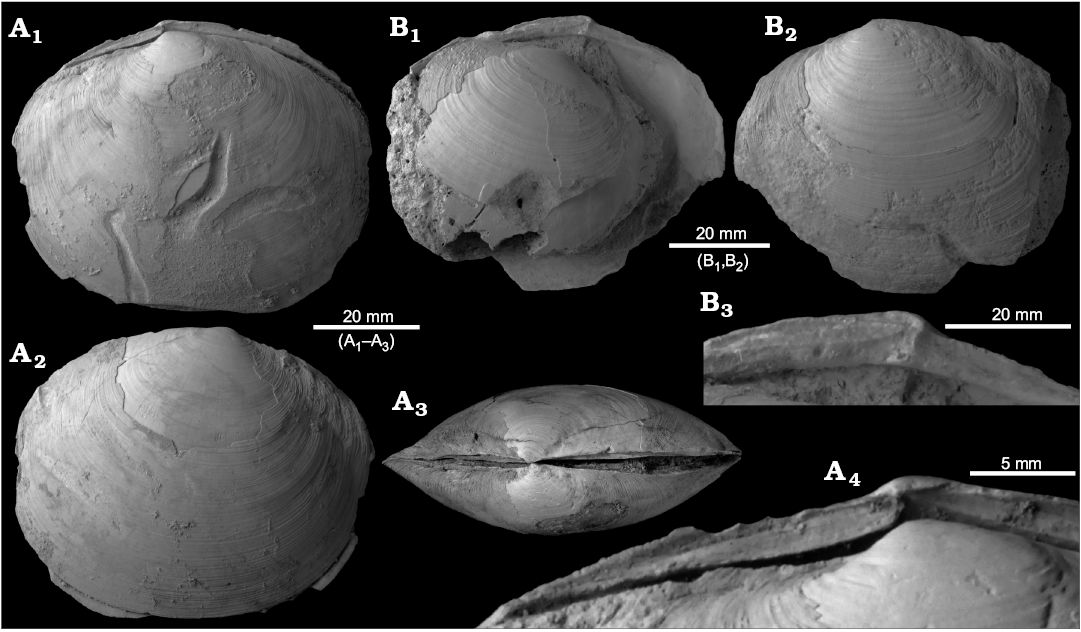
Fig. 10. The lucinid bivalve Elliptiolucina fernandoi sp. nov. from the Pliocene Liog-Liog seep deposit in Leyte, Philippines. A. Holotype NMP-2163, articulated specimen; view on left (A1) and right (A2) valves, view on the dorsal side (A3), close-up on hinge of right valve (A4). B. Paratype NMNS PM 28119, slightly damaged, articulated specimen; view on exterior of right valve and hinge of left valve (B1), view on exterior of left valve (B2), close-up on hinge of left valve (B3).
Remarks.—The three extant species described by Cosel and Bouchet (2008) from deep waters of the Philippines and Indonesia (Elliptiolucina magnifica, E. labeyriei, and E. virginiae) differ from E. fernandoi by being more elongate and, except for E. labeyriei, by having a narrower hinge plate. E. williamsae Glover and Taylor, 2016 from 280–679 m depth in the central Philippines is smaller than E. fernandoi (44.1 mm vs. 68.0 mm maximum length) and it possesses a prominent anterior lateral tooth in the right valve that is missing in E. fernandoi. The extant E. ingens Okutani, 2011 from 576–594 m depth on the slope of the East China Sea (Okutani 2011), growth to bigger size (up to 90.7 mm) and is more inflated than E. fernandoi.
Three fossil species of Elliptiolucina are described to date. The late Oligocene E. washingtonia Kiel, 2013 from western Washington state, USA, is more elongate and has a straighter posterodorsal margin than E. fernandoi. The middle Miocene E. neozelandica Amano, Little, and Campbell, 2018 from the Moonlight North seep deposit in New Zealand (Amano et al. 2018) is much smaller and has more elevated umbones than E. cambantugensis. The late Miocene Elliptiolucina hetzeli (Martin, 1933) from asphalt deposit on Buton Island, Indonesia (Martin 1933; Kiel 2013) is more elongate and has more narrowly rounded anterior and posterior margins compared to E. fernandoi.
Stratigraphic and geographic range.—Late Pliocene to early Pleistocene: Leyte, Philippines.
Genus Divalucina Iredale, 1936
Type species: Lucina cumingi Adams and Angas, 1864, by original designation; Recent, Australia and New Zealand.
Divalucina soyoae Habe, 1952
Fig. 11.
1952 Divaricella soyoae sp. nov.; Habe 1952: 160.
Material.—Five specimens from the Pleistocene of Buhoc Point NMNS PM 28142–28146.
Dimensions (in mm).—NMNS PM 28142, L = 49.0, H = 47.0.
Remarks.—Divalucina soyoae is known from depth of 90 to 200 m in southern Japan (Habe 1952; Dekker and Goud 1994); the genus has not been reported from seep sites before. Extant specimen of Divalucina soyoae are said to reach 47 mm in length (Dekker and Goud 1994), which is only marginally smaller than those reported here. See Dekker and Goud (1994) and Amano (2019) for an extensive synonymy and a summary of fossil and recent occurrence of this species.
Stratigraphic and geographic range.—Late Pliocene: western Honshu, Japan. Pleistocene: eastern Honshu, Japan; Leyte, Philippines. Recent: southern Japan (Amano 2019).

Fig. 11. The lucinid bivalve Divalucina soyoae Habe, 1952 from the early Pleistocene Buhoc Point seep deposit (float) in Leyte, Philippines, NMNS PM 28142, dorsal view (A1), view on right valve (A2).
Genus Lucinoma Dall, 1901
Type species: Lucina filosa Stimpson, 1851, by original designation; Recent, North Atlantic Ocean.
Lucinoma dulcinea Cosel and Bouchet, 2008
Fig. 12.
2008 Lucinoma dulcinea sp. nov.; Cosel and Bouchet 2008: 165, figs. 37A, B, 41A, 44.
2016 Lucinoma dulcinea Cosel and Bouchet, 2008; Glover and Taylor 2016: 133, figs. 31A–N; 32A.
Material.—32 specimens from the Pleistocene of Antipolo Point (Meganodontia bed): NMNS PM 28180 (one articulated specimen), NMNS PM 28181 (one articulated specimen), NMNS PM 28182 (one articulated specimen), NMNS PM 28183 (one articulated specimen), NMNS PM 28458 (four articulated specimens), NMNS PM 28459 (four articulated specimens), NMNS PM 28460 (ten articulated specimens), NMNS PM 28461 (three isolated specimens), NMNS PM 28462 (one articulated specimen), NMNS PM 28463 (one articulated specimen), NMNS PM 28464 (one articulated specimen), NMNS PM 28465 (one articulated specimen), NMNS PM 28466 (one articulated specimen), NMNS PM 28467 (one articulated and one isolated specimens). Two worn specimens from the Pleistocene of Cambantug Point: NMNS PM 28160 (two specimens).
Dimensions (in mm).—NMNS PM 28180, L = 46.1, H = 41.2; NMNS PM 28181, L = 62.0, H = 58.7; NMNS PM28183, L = 50.0, H = 47.5.
Remarks.—Extant Lucinoma dulcinea occurs in the central Philippines (around Leyte and Panglao islands) at depths of 291–786 m (Cosel and Bouchet 2008; Glover and Taylor 2016).
Stratigraphic and geographic range.—Early Pleistocene to Recent: central Philippines.
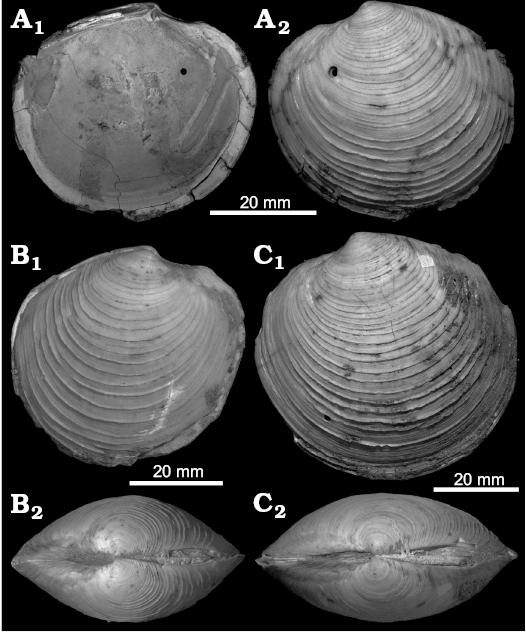
Fig. 12. The lucinid bivalve Lucinoma dulcinea Cosel and Bouchet, 2008 from the Pleistocene Antipolo Point seep deposit in Leyte, Philippines. A. NMNS PM 28180, left valve, inner shell surface showing the very long anterior adductor muscle scar (A1), outer shell surface (A2). B. NMNS PM 28183, articulated specimen, outer shell surface of right valve (B1), dorsal view (B2). C. NMNS PM 28182, articulated specimen, outer shell surface of left valve (C1), dorsal view (C2).
Lucinoma aff. kastoroae Cosel and Bouchet, 2008
Fig. 13.
Material.—Two articulated specimens from the Pliocene of Liog-Liog Point (NMNS PM 28154, 28155).
Remarks.—Overall, the specimens from Liog-Liog Point resemble Lucinoma kastoroae, but differ slightly in being growing to larger size (up to 55 mm length compared to 34 mm in L. kastoroae), by being somewhat taller and by having a slightly less acutely rounded anterior margin. However, we consider these differences too marginal to establish a new species.

Fig. 13. The lucinid bivalve Lucinoma aff. kastoroae Cosel and Bouchet, 2008 from the Pliocene Liog-Liog Point seep deposit, Leyte, Philippines. A. NMNS PM 28154, small articulated specimen, dorsal view showing lunule, escutcheon and ligament (A1), view on right valve (A2). B. NMNS PM 28155, large articulated specimen, views on right (B1) and left (B2) valves.
Lucinoma canudai sp. nov.
Fig. 14.
Zoobank LSID: urn:lsid:zoobank.org:act:AD227C3A-40D4-45BC-B 82A-F075D98C6810
Etymology: In honour of Francisco Canuda (Mines and Geosciences Bureau of the Philippines) for his invaluable assistance with field work.
Type material: Holotype NMP-2167, articulated, inflated specimen with attached burrow. Paratypes: three specimens (NMNS PM 28157–28159) from the type locality.
Type locality: Cambantug Point, Leyte, Philippines.
Type horizon: Lower Pleistocene part of the Bata Formation.
Material.—The type material only.
Dimensions (in mm).—NMP-2167, L = 77.0, H = 71.3, W = 50.3 (articulated).
Diagnosis.—Large, well-inflated Lucinoma, outline angular, umbones blunt, surface sculpture of numerous densely spaced, sharp commarginal ribs, several smaller sharp ridges in interspaces; distinct anterior ridge; posterior sulcus well-developed, lunule long, narrow; ligament long, deeply sunken.
Description.—Large, inflated shell; umbones elevated, blunt; greatest width at middle of shell; anterodorsal margin short, nearly straight, with broad angulation at transition to anterior margin; elevated, blunt ridge running from umbones to anterior end of shell, producing distinct anterodorsal area; posterior area broad, bordered by deep sulcus and distinct ridge running from umbones to posteroventral shell margin; ventral shell margin between ends of those two ridges evenly convex; escutcheon narrow lanceolate, ligament deeply sunken; lunule elongate, deep; surface sculpture of densely spaced, alternating, sharp commarginal ribs.
Remarks.—Lucinoma canudai and also L. velosoi sp. nov. and L. tinagoensis sp. nov., described below), are remarkably more inflated than many species of Lucinoma, both extant (L. yoshidai Habe, 1958, L. kastoroae, and L. dulcinea) and fossil (L. galathea Marwick, 1953, L. gracilistriata Hirayama, 1954, L. shinokii Hirayama, 1954) (Marwick 1953; Hirayama 1954; Habe 1958; Okutani and Hashimoto 1997; Cosel and Bouchet 2008; Glover and Taylor 2016). Lucinoma canudai differs from the two other strongly inflated Lucinoma species reported here (L. velosoi and L. tinagoensis) by its blunt anterior ridge and corresponding broad anterodorsal area, and its much deeper posterior sulcus. Lucinoma saetheri Amano, Little, and Campbell, 2018 from the lower Miocene of New Zealand differs from L. canudai by lacking lamellar sculpture and by having smaller umbones (Amano et al. 2018).
Stratigraphic and geographic range.—Early Pleistocene, Leyte, Philippines.
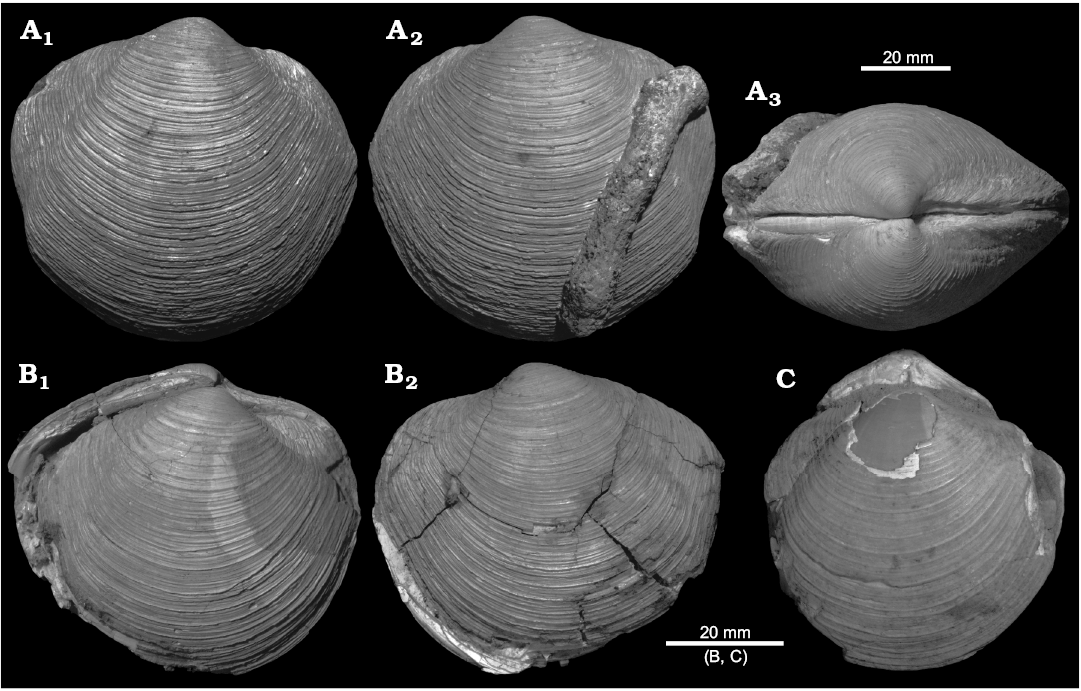
Fig. 14. The lucinid bivalve Lucinoma canudai sp. nov. from the Pleistocene Cambantug Point seep deposit, Leyte, Philippines. A. Holotype NMP-2167, large, articulated specimen with attached, filled burrow; outer surfaces of right (A1) and left (A2) valves; dorsal side (A3). B. Paratype NMNS PM 28157, small specimen showing ligament nymph of left valve. C. Paratype NMNS PM 28158, small specimen with remnants of two cardinal teeth in the left valve.
Lucinoma velosoi sp. nov.
Fig. 15.
Zoobank LSID: urn:lsid:zoobank.org:act:7801672C-99B2-48F7-98AB-EB42257D6E9E
Etymology: In honur of Eduardo Veloso, the landowner of the type locality at Antipolo Point, Leyte, Philippines.
Type material: Holotype NMP-2166, disarticulated right and left valves.
Type locality: Antipolo Point, Leyte, Philippines.
Type horizon: Lower Pleistocene part of the Bata Formation.
Material.—Two specimens from the Pleistocene of Antipolo Point (Meganodontia bed): holotype and NMNS PM 28162; two specimens from the Pleistocene of Cambantug Point: NMNS PM 28161, 28163.
Dimensions (in mm).—NMP-2166, L = 70.9, H = 63.8, W = 45.9 (articulated).
Diagnosis.—Well-inflated Lucinoma, outline rounded-oval, umbones broad, pointed, surface sculpture of numerous densely spaced, sharp commarginal ribs, few indistinct growth increments in interspaces; posterior sulcus indistinct; lunule broad, short; ligament nymph long.
Description.—Strongly and evenly inflated shell (W/H ratio of single valve = 0.37), greatest width at middle of shell; anterodorsal margin slightly concave, with angulation at transition to broadly rounded anterior margin; posterodorsal margin evenly convex, with slight angulation at transition to broadly rounded posterior margin; ventral margin evenly convex, without distinct transitions to anterior and posterior margins; escutcheon lanceolate, greatest width in posterior half; lunule short, broad, deep; hinge plate broad and thick, two thick and short cardinal teeth in each valve, cardinals 1 and 2 pointing downward, cardinals 3 and 4 pointing toward posteroventral margin; ligament nymph lanceolate, about 2/3 of length of posterodorsal shell margin; anterior adductor muscle scar moderately narrow and of moderate length for genus, reaching down to 2/3 of shell height, detached slightly from pallial for ~70% of its length; posterior adductor muscle scar elongate-oval, its lower end situated at about mid-height of shell; shell interior covered by fine striation, most strongly developed at and beyond pallial line.
Remarks.—Lucinoma velosoi differs from the similarly inflated L. tinagoensis described below by reaching a larger size (Table 1), its more elongated shell (that of L. tinagoensis is taller) and its narrower escutcheon. The Pliocene to Recent Lucinoma galathea Marwick, 1953 from New Zealand has a more pointed umbo than L. velosoi, broader and longer ligament nymph, reaches only about 50 mm in length, whereas L. velosoi reaches 70 mm, and is less inflated than L. velosi (Marwick 1953; Campbell et al. 2010).
Stratigraphic and geographic range.—Early Pleistocene, Leyte, Philippines.

Fig. 15. The lucinid bivalve Lucinoma velosoi sp. nov. from the Pleistocene Antipolo Point seep deposits, Leyte, Philippines, holotype NMP-2166, outer surfaces of right (A1) and left (A2) valves; dorsal side (A3); inner surfaces of left (A4) and right (A5) valves; UV light image of right valve highlighting muscle scars, blood vessel scar, and pallial line (A6); close-up on hinges of left (A7) and right (A8) valves.
Table 1. Overview of the characteristics of Lucinoma species discussed here. Abbreviations: H, height; L, length; W, width. Measurements without decimal point were taken from the literature.
|
Species |
L × H × W [mm] |
outline |
inflation |
umbones |
lunule |
posterior sulcus |
|
Lucinoma anemiophila |
61 × 54 × 29 |
rounded-pentagonal |
weak |
small, pointed |
narrow, long |
well developed |
|
Lucinoma annulata |
82 [L] |
roundish |
weak |
small, pointed |
broad, short |
weak |
|
Lucinoma aokii |
76 × 69 × 41 |
roundish-pointed anterior |
moderate |
pointed, prosogyrate |
narrow, long |
weak |
|
Lucinoma dulcinea |
45 × 41 [L × H] |
roundish |
moderate |
small, pointed |
narrow, short |
indistinct |
|
Lucinoma galathea |
50 × 48 [L × H] |
rounded-pentagonal |
weak |
small, pointed |
narrow, long |
weak |
|
Lucinoma gracilistriata |
62 × 51 × 34 |
roundish |
moderate |
pointed, prosogyrate |
narrow, long |
weak |
|
Lucinoma canudai |
77 × 71.3 × 50.3 |
angular |
strong |
blunt |
narrow, long |
well developed |
|
Lucinoma aff. kastoroae |
55 × 48.4 [L × H] |
roundish to rounded-pentagonal |
weak |
small, pointed |
narrow, long |
weak |
|
Lucinoma kastoroae |
34.6 × 28.6 [L × H] |
pentagonal-pointed anteriorly |
weak |
small, pointed |
narrow, long |
weak |
|
Lucinoma kosatorea |
52.7 × 46 [L × H] |
oval, pointed anteriorly |
weak |
small, pointed |
narrow, long |
weak |
|
Lucinoma rhomboidalis |
28.0 × 25.2 [L × H] |
pentagonal |
weak |
pointed, elevated |
broad, short |
weak |
|
Lucinoma saetheri |
67.4 × 63.3 × 37.8 |
roundish |
moderate |
pointed, prosogyrate |
narrow, short |
weak |
|
Lucinoma shinokii |
60 × 53 × 34 |
rounded-pentagonal |
moderate |
blunt, prosogyrate |
broad, short |
well developed |
|
Lucinoma sibogae |
52.2 × 44.0 × 25.5 |
elongate-pentagonal |
weak |
small, pointed |
narrow, long |
weak |
|
Lucinoma taiwanensis |
79.6 × 70.5 × 39.1 |
rounded-pentagonal |
strong |
blunt, prosogyrate |
narrow, long |
weak |
|
Lucinoma tinagoensis |
57.8 × 57 × 38.9 |
rounded-pentagonal |
strong |
pointed, prosogyrate |
broad, short |
weak |
|
Lucinoma velosoi |
70.9 × 63.8 × 45.9 |
rounded-oval |
strong |
broad, pointed |
broad, short |
indistinct |
|
Lucinoma yoshidai |
39 × 35 [L × H] |
rounded-pentagonal |
weak |
pointed, prosogyrate |
narrow, long |
well developed |
Lucinoma tinagoensis sp. nov.
Fig. 16.
Zoobank LSID: urn:lsid:zoobank.org:act:77B57F52-B70F-423A-8914-E0C8C7B5EEB4
Etymology: In reference to the Barangay Tinago, in which the type locality is situated.
Type material: Holotype NMP-2164, an articulated specimen. Paratypes: NMNS PM 28150–28152 (articulated specimens) from the type locality.
Type locality: Cambantug Point, Leyte, Philippines.
Type horizon: Lower Pleistocene part of the Bata Formation.
Material.—The type material only.
Dimensions (in mm).—NMP-2164, L = 57.8, H = 57.0, W = 38.9 (articulated).
Diagnosis.—Medium-large, well-inflated Lucinoma, outline rounded-pentagonal, umbones pointed, markedly prosogyrate for genus; surface sculpture of numerous sharp to cord-like commarginal ribs, several fine commarginal cords in interspaces; posterodorsal area narrow, posterior sulcus not well developed; lunule broad, short; escutcheon long, broad.
Description.—Shell medium-large for genus, greatest width at middle of shell (W/H ratio of single valve = 0.37); anterodorsal margin straight to sinuous, with angulation at transition to somewhat acutely rounded anterior margin; posterodorsal margin evenly convex, with slight angulation at transition to broadly rounded posterior margin; ventral margin evenly convex, without distinct transitions to anterior and posterior margins; shell surface covered by densely spaced, sharp to cord-like commarginal ribs; escutcheon elongate, broad, greatest width in middle; lunule elongate, heart-shaped. Anterior adductor muscle scar moderately narrow, of moderate length for genus, reaching down to ~70% of shell height, detached from pallial by ~30° for c. 2/3 its length.
Remarks.—The early Miocene Lucinoma saetheri differs by its smaller and more pointed umbones, narrower escutcheon (Amano et al. 2018). Lucinoma galathea resembles Lucinoma tinagoensis in outline to but is described as “weakly inflated” (Beu and Maxwell 1990: 281) in contrast to the strong inflation of L. tinagoensis.
Stratigraphic and geographic range.—Early Pleistocene, Leyte, Philippines.

Fig. 16. The lucinid bivalve Lucinoma tinagoensis sp. nov. from the Pleistocene Cambantug Point seep deposit, Leyte, Philippines. A. Holotype NMP-2164, a large, articulated specimen showing external (A1) and internal (A2) features, and its inflation (A3). B. Paratype NMNS PM 28150, showing fine external sculpture on right valve.
Lucinoma kosatorea sp. nov.
Fig. 17.
Zoobank LSID: urn:lsid:zoobank.org:act:47983DA6-3C79-49B9-A174-40BE6795CA49
Etymology: By anagram from kastoroae, a closely related species of Lucinoma.
Type material: Holotype NMNS PM 28164, an isolated left valve.
Type locality: Cambantug Point, Leyte, Philippines.
Type horizon: Lower Pleistocene part of the Bata Formation.
Material.—The holotype only.
Dimensions (in mm).—NMNS PM 28164, L = 52.7, H = 46.0.
Diagnosis.—Medium-sized, little-inflated Lucinoma, outline oval with acutely rounded anterior margin; rounded-pentagonal, umbones small, pointed, prosogyrate; surface sculpture of numerous densely spaced, sharp commarginal ribs, several smaller sharp ridges in interspaces; posterodorsal sulcus very shallow; lunule long, narrow; ligament nymph long.
Description.—Weakly, evenly inflated shell with small, pointed umbones, greatest width at middle of shell; anterodorsal margin undulating, slightly concave, with distinct angulation at transition to acutely rounded anterior margin; posterodorsal margin convex, posterodorsal area broad, bordered by indistinct, low ridge at which commarginal ribs are deflected; ventral margin almost evenly convex, without distinct transitions to anterior margin, and weak angulation at transition to posterior margin; escutcheon lanceolate; lunule long, moderately deep; hinge plate narrow and thick, two thin cardinals in left valve, both pointing downward; thin, elongate anterior lateral tooth in left valve; ligament nymph long, narrow; anterior adductor muscle scar long and narrow, reaching down to 70% of shell height, detached slightly from pallial for c. 70% of its length; posterior adductor muscle scar rounded-oval, its lower end situated at about mid-height of shell; interior of ventral margin marked by two thin ridges with groove in between.
Remarks.—Very similar in shell shape is the Pleistocene Japanese species Lucinoma aokii Hirayama, 1958, but it is larger than L. kosatorea (L = 76.0 mm vs. L = 52.7 mm in L. kosatorea), has a broader lunule with a clearly delimited margin, the hinge plate has an excavated area posterior to the umbo, and the ligament nymph is much narrower than in L. kosatorea (Hirayama 1958). A specimen reported as L. aokii from a Pleistocene seep deposit on the Boso Peninsula in Japan (Shibasaki and Majima 1997: 1068, fig. 4.12): differs from the holotype of L. kosatorea by having a shorter but broader hinge plate, a straighter anteroventral margin, and a distinct external ridge running from the umbo to the anterior shell margin.
Lucinoma canudai, L. velosoi, and L. tinagoensis are much more inflated than Lucinoma kosatorea. A similarly acutely rounded anterior margin is seen in the extant Lucinoma anemiophila Holmes, Oliver, and Sellanes, 2005 from methane seeps off of central Chile. But L. anemiophila has a truncated, angular posterior margin and a more distinctive posterior ridge than Lucinoma kosatorea (Holmes et al. 2005).
Stratigraphic and geographic range.—Early Pleistocene, Leyte, Philippines.
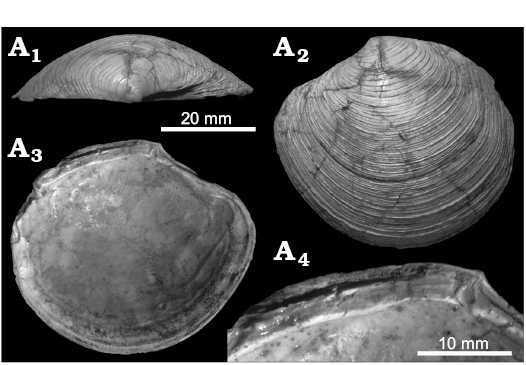
Fig. 17. The lucinid bivalve Lucinoma kosatorea sp. nov. from the Pleistocene Cambantug Point seep deposit, Leyte, Philippines, holotype NMNS PM 28164, an isolated left valve; dorsal side (A1), exterior surface showing sculpture (A2), interior surface showing muscle scars and pallial line (A3), close-up on hinge (A4).
Family Vesicomyidae Dall and Simpson, 1901
Genus Vesicomya Dall, 1886
Type species: Callocardia atlantica Smith, 1885, by original designation; Recent, Azores to Cape Verde Basin.
Vesicomya margotae Beets, 1953
Fig. 18.
1953 Vesicomya (Waisiuconcha) margotae sp. nov.; Beets 1953: 255, pl. 1: 11–15.
Material.—Seven specimens from the Pliocene of Liog-Liog Point: NMNS PM 28410, 28411, 28412 (five individuals).
Dimensions (in mm).—NMNS PM 28410, L = 8.3, H = 6.9; NMNS PM 28411, L = 12.5, H = 10.0.
Remarks.—Vesicomya margotae has a hinge dentition like Vesicomya (Beets 1953: pl. 1: 11, 15) and should therefore not be associated with Waisiuconcha. A very similar extant species is Vesicomya katsuae Kuroda, 1952 from 200–400 m depth in Sagami and Tosa Bays, Japan. That species has a Vesicomya-like hinge (Kuroda 1952: figs. 7–9) and a lunular incision (Kuroda 1952: fig. 5), which identifies it as a member of Vesicomya and not of Waisiuconcha (cf., Habe 1976b; Cosel and Salas 2001). Vesicomya margotae differs from V. katsuae by being less elongate and having larger and more elevated umbones. The extant Japanese species Vesicomya nakaii Okutani, 1962, reported here from the late Pliocene of Cambantug Point (below), differs from both V. margotae and V. katsuae by being shorter and higher, and by having more prominent and elevated umbones.
Stratigraphic and geographic range.—Late Miocene: southern Sulawesi, Indonesia. Late Pliocene: Leyte, Philippines.

Fig. 18. The vesicomyid bivalve Vesicomya margotae Beets, 1953 from the late Pliocene seep deposit at Liog-Liog Point, Leyte, Philippines. A. NMNS PM 28410, articulated specimen, view on left valve (A1), dorsal view (A2), view on right valve (A3), note drill hole. B. NMNS PM 28411, isolated left valve, view on exterior (B1), dorsal view showing lunular incision, (B2), view on inner side (B3), and close-up on hinge dentition (B4).
Vesicomya nakaii Okutani, 1962
Fig. 19A.
1962 Vesicomya nakaii sp. nov.; Okutani 1962: 22, pl. 4: 1a.
2000 Vesicomya nakaii Okutani, 1962; Okutani 2000: 997, pl. 496: 1.
Material.—One left valve on small block from the Pleistocene of Cambantug Point: NMNS PM 28413 (L = 8.0 mm, H = 7.3 mm).
Remarks.—Cosel and Salas (2001) considered V. nakaii as belonging to Isorropodon, but the species has a distinct lunular incision and hence belongs to Vesicomya. The specimen illustrated here from Cambantug Point has the posterior ridge and truncate posterior margin of V. nakaii, whereas V. margotae from Liog-Liog Point is posteriorly more elongated. The specimen clearly shows a lunular incision. Unfortunately, the hinge of our specimen is concealed in rock matrix.
Stratigraphic and geographic range.—Early Pleistocene: Leyte, Philippines. Recent: west coast of Kyushu, Japan.
Genus Isorropodon Sturany, 1896
Type species: Isorropodon perplexum Sturany, 1896, by monotypy; Recent, eastern Mediterranean Sea.
Remarks.—The differences between Isorropodon and Vesicomya were defined as follows: “Isorropodon is distinguished from Vesicomya by the much larger and more oval to oval-oblong shell, the poorly developed to missing lunular incision and the smooth valve margins without an incision. Vesicomya is smaller, the shells are very tumid to nearly spherical, the general hinge teeth configuration however is the same in both” (Cosel and Salas 2001).
Isorropodon cf. perplexum Sturany, 1896
Fig. 19B–E.
Material.—Six specimens from the Pliocene of Liog-Liog Point (NMNS PM 28414–28416, and NMNS PM 28418, representing three specimens); one specimen from the Pleistocene of Cambantug Point (NMNS PM 28417).
Dimensions (in mm).—NMNS PM 28415, L = 10.0, H = 7.8; NMNS PM 28416: L = 11.0, H = 8.5.
Remarks.—The available specimens are virtually indistinguishable from the syntypes of I. perplexum as illustrated by Cosel and Salas (2001: figs. 33–35), but with the hinge dentition of the Philippine specimens unknown, we only hesitantly assign them to the extant Mediterranean species I. perplexum.
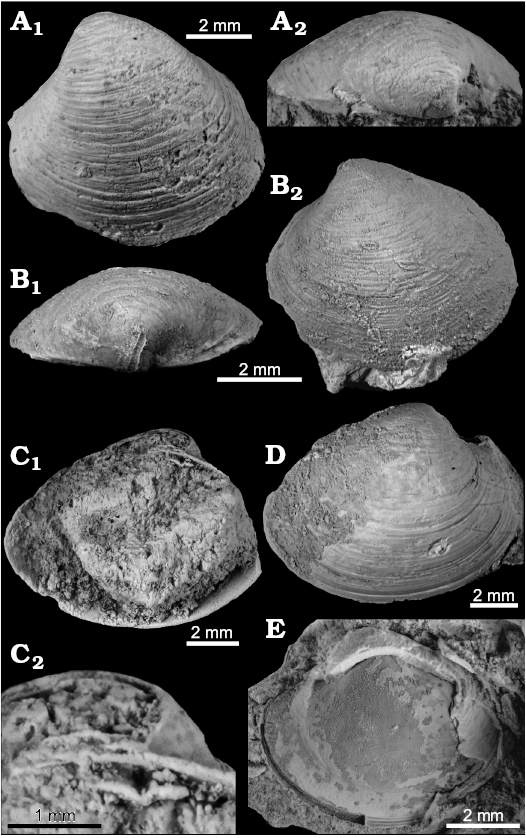
Fig. 19. Small vesicomyid bivalves from late Pliocene (B–D, Liog-Liog Point) and early Pleistocene (A, E, Cambantug Point) seep deposits in Leyte, Philippines. A. Vesicomya nakaii Okutani, 1961, NMNS PM 28413, isolated left valve, view on outer side. B–D. Isorropodon cf. perplexum Sturany, 1896. B. NMNS PM 28414, small left valve, outside view (B1) and dorsal view (B2). C. NMNS PM 28415, isolated left valve, insight view (C1); close-up on hinge (C2). D. NMNS PM 28416, isolated right valve, view on outer shell surface. E. Isorropodon cf. perplexum Sturany, 1896, NMNS PM 28417, left valve with shell broken off, showing anterior adductor muscle scar.
Genus Archivesica Dall, 1908b
Type species: Callocardia gigas Dall, 1896, by original designation; Recent, Gulf of California.
Archivesica kawamurai (Kuroda, 1943)
Fig. 20.
1943 Akebiconcha kawamurai sp. nov.; Kuroda 1943: 14–18, text-figs. 1–3, pl. 13.
Material.—14 specimens from the Pleistocene of Cambantug Point: NMNS PM 28173, 28174, 28223–2830, 28305–28308. Two specimens from the Pliocene of Liog-Liog Point: NMNS PM 28192, 28193.
Dimensions (in mm).—NMNS PM 28173, L = 109.1, H = 53.3; NMNS PM 28174, L = 109.1, H = 52.9.
Remarks.—See Amano and Kiel (2010) for an extensive synonymy.
Stratigraphic and geographic range.—Pliocene–Pleistocene: Pacific side of central Japan to Leyte, Philippines. Recent: Pacific side of central to southern Japan (Amano and Jenkins 2011; Amano et al. 2019).
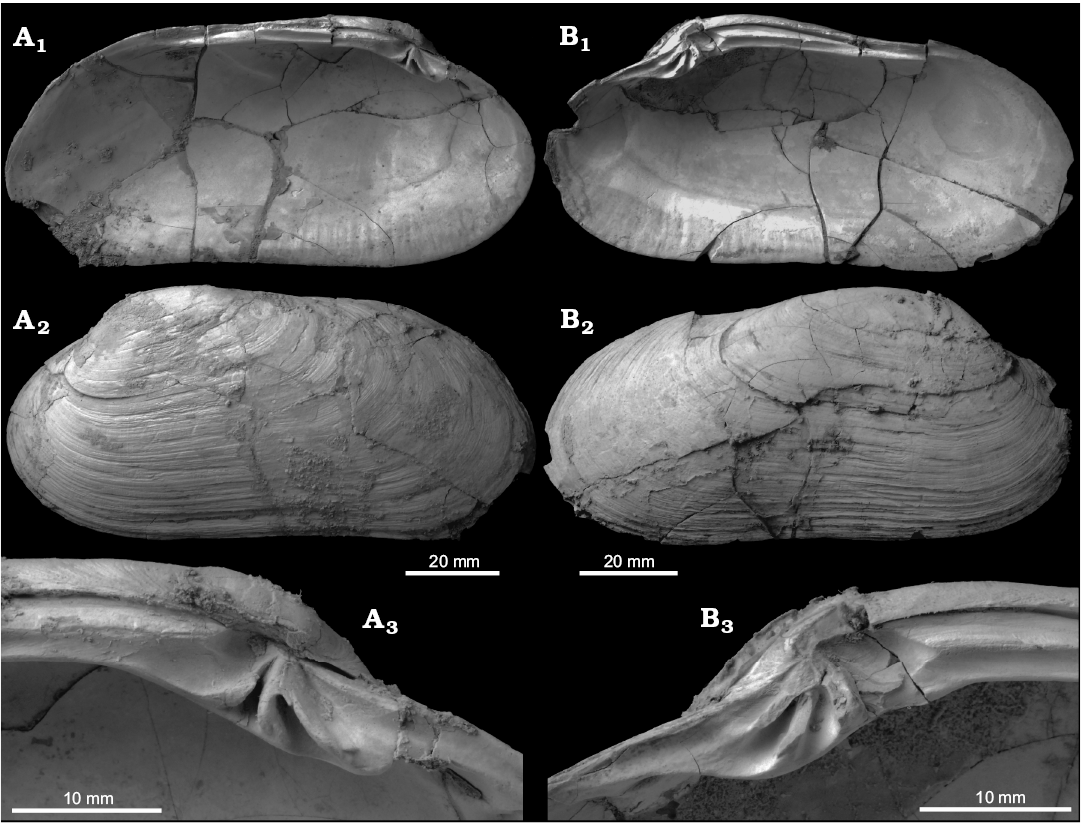
Fig. 20. The vesicomyid bivalve Archivesica kawamurai (Kuroda, 1943) from the Pleistocene Cambantug Point seep deposit in Leyte, Philippines. A. NMNS PM 28174, left valve, inside (A1), outside (A2), close-up on hinge (A3). B. NMNS PM 28173, right valve, inside (B1), outside (B2), close-up on hinge (B3).
Archivesica pastori sp. nov.
Fig. 21.
Zoobank LSID: urn:lsid:zoobank.org:act:6D1578D2-432D-4FB2-9173-5BE9500E7DA3
Etymology: In honour of Douglas Pastor, owner of the property of the type locality at Liog-Liog Point, Leyte, Philippines.
Type material: Holotype NMP-2165a, a disarticulated right valve. Paratypes: NMNS PM 28194–28196 (a right valve and two left valves), NMP-2165b (left valve), NMNS PM 28206 (right valve) from the type locality.
Type locality: Liog-Liog Point, Leyte, Philippines.
Type horizon: Lower Pliocene part of the Bata Formation.
Material.—22 specimens from the type locality: type material and NMP-2165a (representing 16 specimens) and 21 paratypes, NMP-2165b, NMNS PM 28194–28196, 28206–28222.
Dimensions (in mm).—NMP-2165a, L = 143.2, H = 69.0.
Diagnosis.—Large, elongate Archivesica with three radiating teeth in each valve, cardinal 2b very thick, cardinal 3a occasionally reduced, cardinals 3b and 4b short; ligament nymph about half of total shell length.
Description.—Large elongate-oval shell, umbones blunt, elevated, slightly prosogyrate, situated anterior at c. 26–31% of total shell length; anterodorsal margin straight; anterior margin acutely rounded, anterior-most point somewhat above midline of shell; ventral margin straight or slightly concave; posterior margin broadly rounded; posterodorsal margin gently sloping. Hinge plate strong, broad, with three relatively thick cardinals in each valve, radiating outward from underneath umbo; right valve: cardinal 1 elongate, protruding, pointing anteroventrally, 3a elongate, subparallel to shell margin, reduced, 3b elongate-triangular, pointing posterodorsally; left valve: cardinal 2a moderately thin and of same length or longer as 2b, pointing anterorventrally, 2b triangular, thick, occasionally bifid, pointing to center of ventral margin, cardinal 4 short, narrow, pointing posterior, with shallow, elongate posterior depression; nymph plate elongate, about ½ of total shell length, starts tapering posteriorly after about half its length. Outer shell surface with faint, irregular growth increments.
Remarks.—Very similar regarding hinge dentition are the extant Japanese species Archivesica similaris (Okutani et al. 1997) and Archivesica tsubasa (Okutani et al. 2000), but both are more elongate than Archivesica pastori. As a result of being more elongate, their dorsal and ventral margins are more parallel than in A. pastori. However, this feature shows some variability in A. pastori, for example the specimen shown on Fig. 21B1 has rather parallel dorsal and ventral margins, but is not as elongate as A. similaris and A. tsubasa. Another extant species with similar hinge dentition is Archivesica ochotica Scarlato, 1981, which is less elongate compared to A. pastori and has a proportionally shorter ligament nymph (Scarlato 1981). The early Miocene Japanese Archivesica sakoi Amano, Jenkins, Ohara, and Kiel, 2014 also shows a similar hinge dentition and overall shape, but its cardinal 3b in the right valve is more elongate and subparallel the shell margin unlike the shorter and oblique tooth of A. pastori, and A. sakoi also has more prominent and more prosogyrate umbones (Amano et al. 2014), and is much smaller (L = 80 mm in A. sakoi compared to L = 143 mm in A. pastori).
The hinge dentition of A. pastori is also somewhat similar to that of Archivesica magnocultellus (Okutani et al. 2002) except that A. pastori lacks the large pit posterior to the cardinals seen in A. magnocultellus. Archivesica pastori differs from the type species of Archivesica, A. gigas (Dall 1896), by having a short cardinal 2a and a strong, thick cardinal 2b in the left valve, whereas A. gigas has a very elongate 2a and a narrow 2b. Furthermore, A. pastori has a long ligament nymph (c. ½ of shell length), whereas the ligament nymph is short in A. gigas.
Stratigraphic and geographic range.—Late Pliocene, Leyte, Philippines.
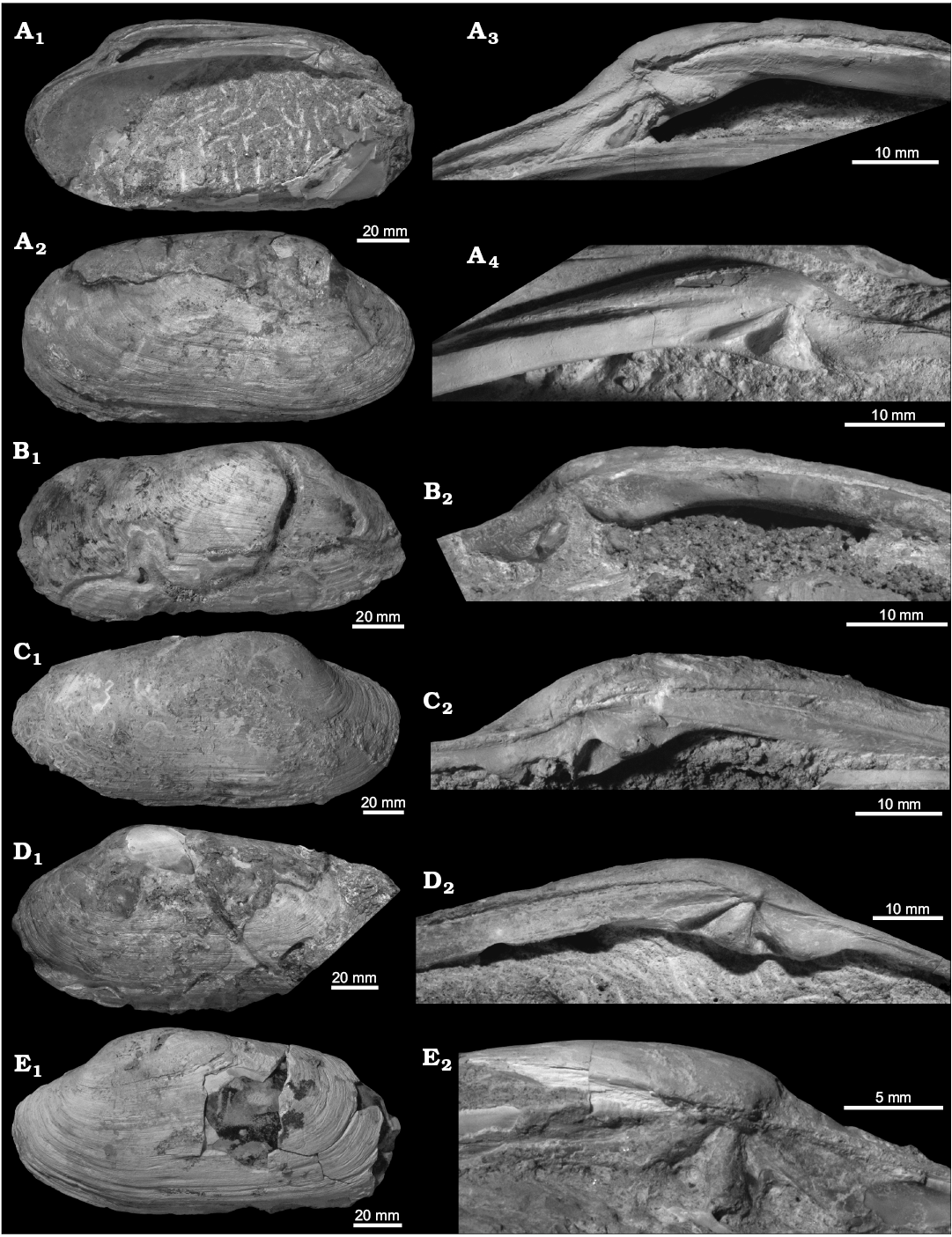
Fig. 21. The vesicomyid bivalve Archivesica pastori sp. nov. from the late Pliocene Liog-liog Point seep deposit. A. Left valve (paratype NMP-2165b) and right valve (holotype NMP-2165a) nested into one another; inside view of the two shells (A1), outside view on RW (A2), close-up on hinge of RV (A3); close-up on hinge of LV (A4). B. Paratype NMNS PM 28206, large isolated right valve with broad posterodorsal area, outside view (B1), close-up on hinge (B2). C. Paratype NMNS PM 28194, large isolated right valve with gently sloping posterodorsal margin; outside view (C1), close-up on hinge (C2). D. Paratype NMNS PM 28195, isolated left valve, posteriorly damaged, outside view (D1), close-up on hinge (D2). E. Paratype NMNS PM 28196, disarticulated left valve, outside view (E1) and close-up on hinge (E2).
Genus Pliocardia Woodring, 1925
Type species: Anomalocardia bowdeniana Dall, 1903, by original designation; Pliocene, Bowden Formation, Jamaica.
Remarks.—Molecular data indicate that species currently assigned to Pliocardia (cf., Krylova and Sahling 2010) belong to two distinct clades (Audzijonyte et al. 2012; Valdés et al. 2013; Johnson et al. 2017). The first clade includes “Pliocardia” cordata and “Pliocardia” ponderosa and is referred to as “Pliocardia 1” by Valdés et al. (2013) and as “cordata group” by Johnson et al. (2017). The second clade includes P. kuroshimana and P. crenulomarginata and was called “Pliocardia 2” by Valdés et al. (2013) and “Pliocardia” by Johnson et al. (2017). It remains unclear, however, to which, if any, of these two clades the fossil type species belongs. Hence, we use Pliocardia here in inverted commas only.
Pliocardia kuroshimana (Okutani, Fujikura, and Kojima, 2000)
Fig. 22.
2000 Vesicomya kuroshimana sp. nov.; Okutani et al.: 83–84, figs. 2, 6.
2000 Vesicomya kuroshimana Okutani, Fujikura, and Kojima, 2000; Okutani 2000: 996–997, pl. 496.
Material.—Eight specimens from early Pleistocene non-seep sediments at the tip of Liog-Liog Point (NMNS PM 28189–28191 and five unnumbered specimens).
Dimensions (in mm).—NMNS PM 28189, L = 48.0, H = 36.6; NMNS PM 28190, L = 48.0, H = 36.3; NMNS PM 28191, L = 48.0, H = 36.6.
Remarks.—The largest extant specimen is 58.9 mm long (Okutani et al. 2000) whereas the largest early Pleistocene specimen from Liog-Liog Point is only 48.0 mm long. But morphologically we see no difference between the extant and the Pliocene specimens. This is the first fossil record of “Pliocardia” kuroshimana; despite Japan’s a rich Plio-Pleistocene fossil of chemosymbiotic bivalves, no Pliocardia has been reported from sediments of Plio-Pleistocene age yet (Amano and Jenkins 2011; Amano et al. 2019). Pliocardia kawadai (Aoki, 1954) is known from the early to middle Miocene, and Pliocardia? tanakai Miyajima, Nobuhara, and Koike, 2017 is known from the middle Miocene (Aoki 1954; Miyajima et al. 2017; Amano et al. 2019).
Stratigraphic and geographic range.—Early Pleistocene, Leyte, Philippines. Recent: Okinawa Trough.
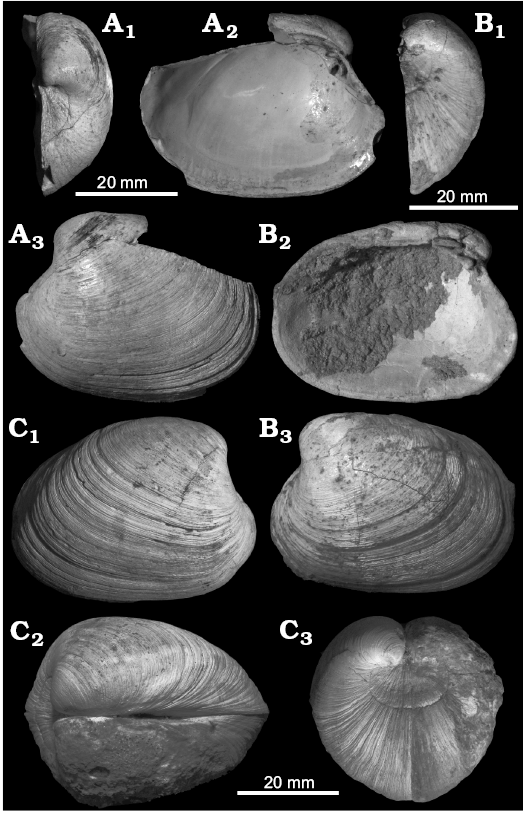
Fig. 22. The vesicomyid bivalve “Pliocardia” kuroshimana (Okutani, Fujikura and Kojima, 2000) from early Pleistocene non-seep deposits at the tip of Liog-Liog Point in Leyte, Philippines. A. NMNS PM 28190, partially broken left valve, anterior side showing lunular incision (A1), inner shell surface and hinge (A2), outer shell surface (A3). B. NMNS PM 28191, left valve, anterior side showing lunular incision (B1), inner shell surface (B2), outer shell surface (B3). C. NMNS PM 28189, articulated specimen, outer shell surface of right valve (C1), dorsal view showing the strong inflation (C2), anterior side showing lunular incision (C3).
Clade Pliocardia “cordata group”
Remarks.—“Pliocardia” ticaonica reported below was considered very closely related to “Pliocardia” cordata (cf., Boss 1968) and hence most likely belong to the “cordata group” sensu Johnson et al. (2017).
“Pliocardia” ticaonica Dall, 1908a
Fig. 23.
1908 Vesicomya ticaonica sp. nov.; Dall 1908a: 63.
Material.—Three disarticulated specimens from the Pleistocene of Cambantug Point (NMNS PM 28184–28186).
Dimensions (in mm).—NMNS PM 28185, L = 68.2, H = 52.5.
Remarks.—Huber (2010) considered “Pliocardia” ticaonica as a synonym of “Pliocardia” indica (Smith, 1904). However, “Pliocardia” ticaonica is more elongate than “P.” indica, and “P.” indica has a more distinctive lunular incision than “P.” ticaonica. Hence, we prefer to retain the name “P.” ticaonica. The original description of Vesicomya ticaonica did not include a figure (Dall 1908a). Although we have not seen the holotype of P. ticaonica, the Philippine Pliocene specimens are indistinguishable from two specimens labeled “Vesicomya ticaonica”, housed in the USNM (USNM 248063 from the Philippines, station 5446 and USNM 229320 from Sibuko Bay, Borneo, Indonesia, station 5592).
When Boss (1968) described “Pliocardia” cordata, he considered it “remarkably similar, and probably most closely related, to V. ticaonica Dall” (Boss 1968: 735). The two shells are indeed very similar, and we concur with this view. Boss (1968) also considered the late Miocene Waisiuconcha alberdinae Beets, 1942 from Buton Island, Sulawesi, Indonesia, as a precursor or possibly even as a synonym of V. ticaonica. However, whether the much smaller (23 mm) and thin-shelled W. alberdinae is indeed closely related to the thick-shelled “P.” ticaonica and “P.” cordata remains to be tested.
Stratigraphic and geographic range.—Early Pleistocene, Leyte, Philippines. Recent: Philippines and Indonesia.
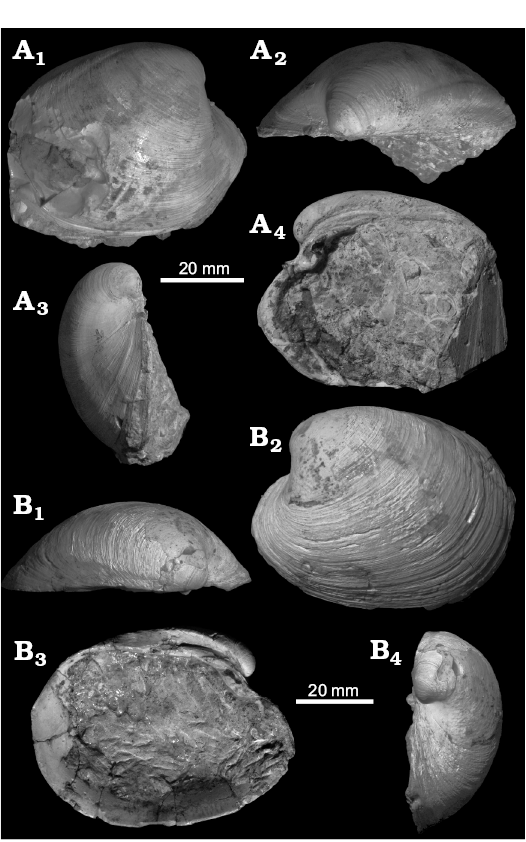
Fig. 23. The vesicomyid bivalve “Pliocardia” ticaonica Dall, 1908 from the early Pleistocene Cambantug Point seep deposit in Leyte, Philippines. A. NMNS PM 28186, right valve, outer shell surface (A1), dorsal side (A2), anterior side (A3), inner side showing hinge (A4). B. NMNS PM 28185, left valve, dorsal side (B1), outer shell surface (B2), inner side showing hinge (B3), anterior side (B4).
“Pliocardia” indica (Smith, 1904)
Fig. 24.
1904 Vesicomya indica sp. nov.; Smith 1904: 9.
Material.—One right valve from the Pleistocene of Cambantug Point NMNS PM 28419 (L = 45.9 mm, H = 38.8 mm).
Remarks.—For comments on the synonymy of “P.” indica and “P.” ticaonica see above.
Stratigraphic and geographic range.—Early Pleistocene, Leyte, Philippines. Recent: Bay of Bengal.
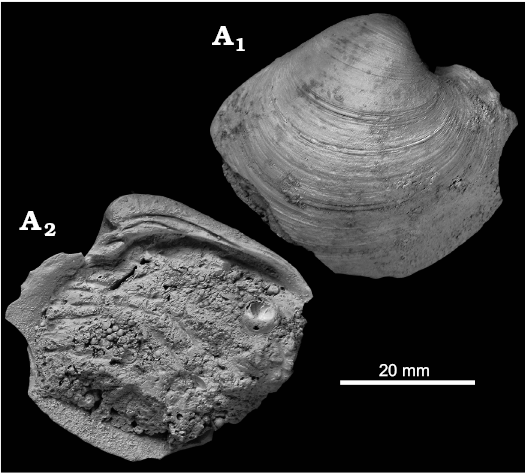
Fig. 24. The vesicomyid bivalve “Pliocardia” indica (Smith, 1904) from the early Pleistocene seep deposit at Cambantug Point, Leyte, Philippines, NMNS PM 28419, an isolated right valve, seen from the outside (A1) and inside (A2).
Genus Wareniconcha Cosel and Olu, 2009
Type species: Vesicomya guineensis Thiele and Jaeckel, 1931, by original designation; Recent, from ca. 2500 to 4000 m depth on the West African continental margin (Cosel and Olu 2009).
Wareniconcha guineensis (Thiele and Jaeckel, 1931)
Fig. 25.
1931 Vesicomya guineensis sp. nov.; Thiele and Jaeckel 1931: 229, pl. 9: 102.
1970 Vesicomya (Vesicomya) guineensis Thiele and Jaeckel, 1931; Boss 1970: 71–72, figs. 5–6, 18–19.
2009 Wareniconcha guineensis (Thiele and Jaeckel, 1931); Cosel and Olu 2009: 2362, figs. 11–14, 29G–H.
Material.—Five specimens from the Pliocene of Liog-Liog Point (NMNS PM 28197–28201). NMNS PM 28197: L = 46.9 mm, H = 35.5 mm; NMNS PM 28199: L = 37.0 mm, H = 30.4 mm.
Remarks.—Cosel and Olu (2009) documented shell shape and hinge variability for Wareniconcha guineensis and the specimens from Liog-Liog Point fall well within this variability. In particular, specimen NMNS PM 28199 has a very similar outline as the Wareniconcha guineensis syntype stored at the Museum für Naturkunde, Berlin (Moll.101.600).
Stratigraphic and geographic range.—Late Pliocene: Leyte, Philippines. Recent: west coast of tropical Africa.
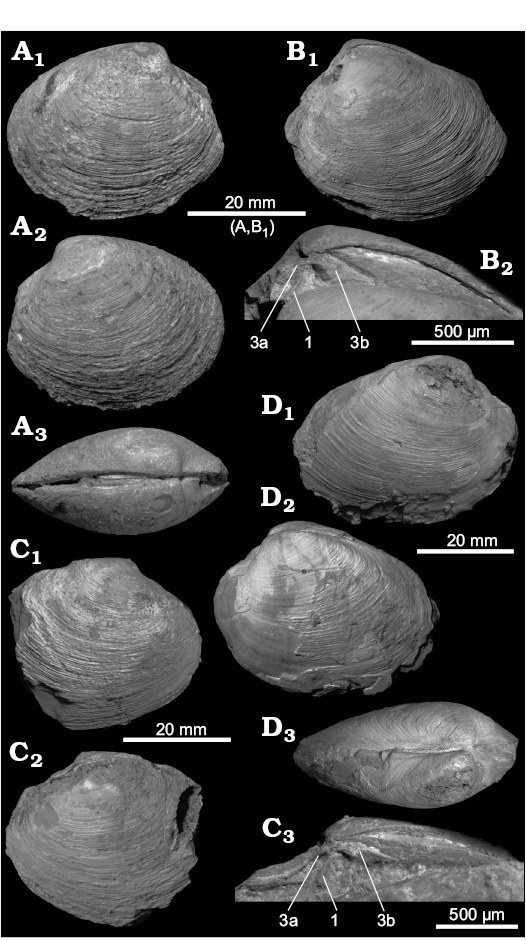
Fig. 25. The vesicomyid bivalve Wareniconcha guineensis (Thiele and Jaeckel 1931) from the late Pliocene Liog-Liog Point seep deposit in Leyte, Philippines. A. NMNS PM 28199, oval-round articulated specimen, right valve (A1), left valve (A2), dorsal view (A3). B. NMNS PM 28200, oval-round articulated specimen, left valve (B1), close-up on hinge of right valve (B2). C. NMNS PM 28201, articulated specimen, right (C1) and left (C2) valve; close-up on RV hinge (C3). D. NMNS PM 28197, articulated elongate-oval specimen, right (D1) and left (D2) valves; dorsal view (D3). Numbers indicate cardinal teeth.
Wareniconcha aff. winckworthi (Prashad, 1932)
Fig. 26.
Material.—Two specimens from the Pliocene of Liog-Liog Point: NMNS PM 28187, a right valve with partly exposed hinge and NMNS PM 28188, an articulated specimen.
Dimensions (in mm).—NMNS PM 28187, L = 64.0, H = 56.6; NMNS PM 28188, L = 58.0, H = 44.1.
Remarks.—Wareniconcha aff. winckworthi is slightly more inflated and has broader umbones than the extant Wareniconcha winckworthi from Indonesia (Prashad 1932). Furthermore, it has a truncate posterior margin (see Fig. 26B2) whereas it is more obliquely truncated in Wareniconcha winckworthi; however, this difference might not be a distinguishing character but instead a case of intraspecific dimorphism, as reported for example for the vesicomyid genus Calyptogena (see Krylova and Sahling 2006). The recently described Wareniconcha mercenarioides Kase, Isaji, Aguilar, and Kiel, 2019 from the same seep deposit is much larger (up to 120 mm) and has a roundish-triangular outline, whereas W. aff. winckworthi has an oval outline.
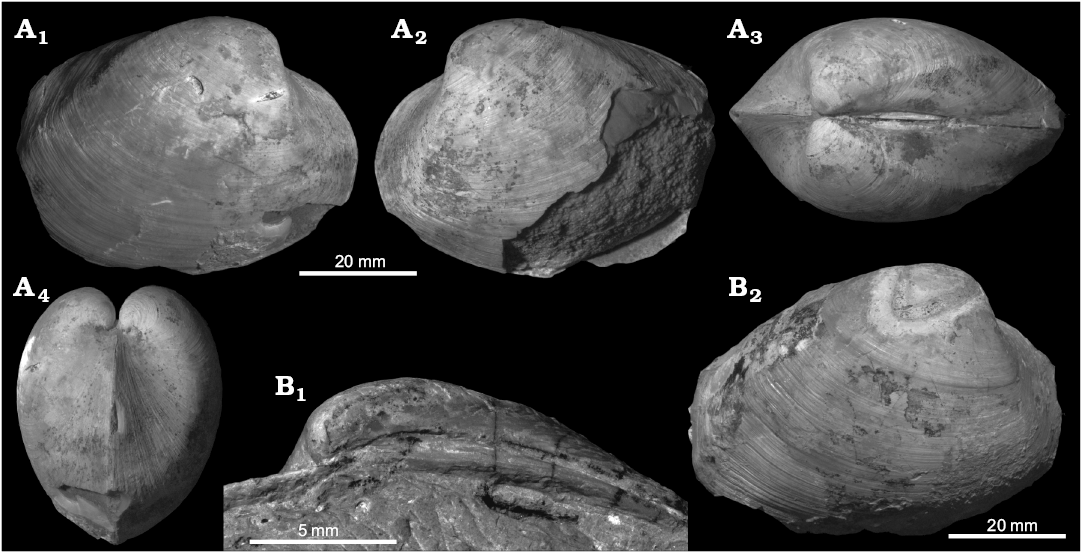
Fig. 26. The vesicomyid bivalve Wareniconcha aff. winckworthi (Prashad, 1932) from the Pliocene Liog-Liog Point seep deposit in Leyte, Philippines. A. NMNS PM 28188, articulated specimen, with views on right (A1) and left (A2) valves, dorsal (A3) and anterior (A4) sides. B. NMNS PM 28187, right valve with hinge partly exposed, close-up on hinge (B1), view on outer shell surface (B2).
Genus Waisiuconcha Beets, 1942
Type species: Waisiuconcha alberdinae Beets, 1942, by original designation; Buton Island, Indonesia, late Miocene (Janssen 1999).
Remarks.—According to Cosel and Salas (2001: 339) there are “two Recent species described from Japan: Waisiuconcha katsuae (Kuroda 1952), and W. surugensis Habe, 1976 (Habe 1976a: fig. 81) (see also Higo et al. 1999); a third Japanese species cited by these authors in the genus Waisiuconcha, W. nakaii (Okutani 1962) may be, according to the original drawing (Okutani 1962: pl. 4: 1a), a species of Isorropodon”. “Waisiuconcha” margotae Beets, 1953 from the late Miocene asphalt beds of Buton Island, Indonesia, looks quite like Vesicomya katsuae and might be the same as the Vesicomya from Liog-Liog. Vesicomya katsuae and Vesicomya nakaii were assigned to Waisiuconcha by Habe (1976a).
Waisiuconcha sp. 1
Fig. 27A–C.
Material.—Three specimens from the Pliocene of Liog-Liog Point (NMNS PM 28420–28422).
Dimensions (in mm).—NMNS PM 28420, L = 4.5, H = 3.5.
Remarks.—Compared to the holotype of Waisiuconcha alberdinae Beets, 1942 (Beets 1942: figs. 147–151), Waisiuconcha sp. 1 from Liog-Liog Point has a more acutely rounded posterior margin, the anterior adductor muscle scar is more elongate than the diamond to drop-shaped scar of W. alberdinae, the pallial line starts at the base of the anterior adductor scar rather than on its posteroventral side, and the pallial line is closer to the shell margin as in W. alberdinae. The two extant species W. surugensis Habe, 1976a and W. haekeli Cosel and Salas, 2001 have shorter shells than Waisiuconcha sp. 1 from Liog-Liog Point (Habe 1976a; Cosel and Salas 2001; Hoffman et al. 2019).
Waisiuconcha sp. 2
Fig. 27D, E.
Material.—Two specimens from the Pleistocene of Cambantug Point (NMNS PM 28423, 28424).
Dimensions (in mm).—NMNS PM 28423, L = 3.5, H = 2.5; NMNS PM 28424, L = 3.5, H = 2.8.
Remarks.—The early Pleistocene Waisiuconcha sp. 2 has a more distinctive lunular incision and more elevated umbones than the late Pliocene Waisiuconcha sp. 1 reported above from Liog-Liog Point.

Fig. 27. Two species of the vesicomyid bivalve genus Waisiuconcha Beets, 1942, from the late Pliocene (A–C, Liog-Liog Point) and early Pleistocene (D, E, Cambantug Point) seep deposits in Leyte, Philippines. A–C. Waisiuconcha sp. 1. A. NMNS PM 28420, articulated specimen, dorsal view showing lunular incision (A1), view on outer side of left valve (A2). B. NMNS PM 28421, articulated specimen with partically removed shell, view on outer side of left valve (B1), anterior view showing anterior adductor muscle scars (B2). C. NMNS PM 28422, isolated left valve, showing hinge dention. D, E. Waisiuconcha sp. 2. D. NMNS PM 28423, an isolated right valve partially embedded in rock matrix, showing hinge dentition (D1), view on outer side (D2), in dorsal view showing lunular incision (D3). E. NMNS PM 28424, an isolated left valve, showing hinge dention (E1) and irregular outer surface sculpture (E2).
Class Gastropoda Cuvier, 1795
Limpets of uncertain affinities
Remarks.—In the absence of data on shell microstructure and protoconch, the four species reported below are difficult to place. Serradonta Okutani, Tsuchida, and Fujikura, 1992 and Bathyacmaea Okutani, Tsuchida, and Fujikura, 1992 (Pectinodontidae) have been shown to vary greatly in outline (from oval to pointed egg-shaped), in the position of the apex (subcentrally to displaced anteriorly) and surface sculpture (from nearly smooth to having strong beaded radial ribs), both within genera as well as within species (Chen et al. 2019). Very similar external morphologies are for example also found among member of the paralepetopsids and neolepetopsids (McLean 1990, 2008, Warén and Bouchet 2009).
Limpet gastropod sp. 1
Fig. 28A–D.
Material.—Eight specimens from the Pliocene of Liog-Liog Point: NMNS PM 28427–28430; NMNS PM 28431 (attached to the same block as Archivesica kawamurai NMNS PM 28192), and three unnumbered specimens; one specimen from the Pleistocene of Antipolo Point (unnumbered).
Dimensions (in mm).—NMNS PM 28429, L = 11.0, W = 9.3.
Description.—Moderately elevated limpet (H/L ratio ~0.46), apex displaced slightly toward the anterior, outline oval with anterior side slightly narrower than posterior side, flanks more-or-less straight; external surface with concentric growth rings only, or with numerous narrowly spaced, tuberculate radial ribs; base straight or slightly convex.
Remarks.—Similar species can be found among the pectinodont patellogastropod genus Serradonta Okutani, Tsuchida, and Fujikura, 1992, which is a morphologically variable genus that includes axially ribbed as well as smooth species, with a fossil record ranging back into the Cretaceous (Okutani et al. 1992; Jenkins et al. 2007; Chen et al. 2019). Neolepetopsids such as Neoplepetopsis McLean, 1990 and Paralepetopsis McLean, 1990 are another group of patellogastropods with similar shells (McLean 1990, 2008). Cocculiniform limpets with oval, radially ribbed shells with subcentral apex are known from the genera Coccocrater Haszprunar, 1987 and Coccopigya Marshall, 1986 (Marshall 1986; Haszprunar 1987; McLean and Harasewych 1995); the latter has a fossil record ranging back to the early Oligocene (Kiel et al. 2020).
Limpet gastropod sp. 2
Fig. 28E.
Material.—One specimen from the Pleistocene of Antipolo Point: NMNS PM 28432 (L = 8.5 mm, W = 9.5 mm, H = 3.4 mm).
Description.—Low to moderately elevated limpet (H/L ratio ~0.4), outline irregularly-round, apex displaced anteriorly; anterior slope straight, posterior slope slightly convex; pallial attachment line close to base; two elongate, slightly curved muscle scars at about 1/3 of shell height, one on each lateral side of shell, tapering slightly anteriorly, posterior end broadened.
Remarks.—The two subparallel muscle attachment scars combined with the almost circular base of the shell are unusual among limpet gastropods, and we have not found a suitable taxonomic place for it.
Limpet gastropod sp. 3
Fig. 28F, G.
Material.—Two specimens from the Pleistocene of Antipolo Point (NMNS PM 28433, 28434).
Dimensions (in mm).—NMNS PM 28433, L = 4.9, W = 3.6, H = 1.7; NMNS PM 28434, L = 5.0, W = 3.5, H = 1.8.
Description.—Moderately elevated limpet (H/L ratio ~0.34), outline evenly oval, apex central, base slightly convex; inner surface with fine radial striations; flanks very slightly convex.
Remarks.—The outer shell surface is missing in both specimens; hence the external sculpture is unknown. Compared to limpet sp. 1, these specimens are generally smaller, have a lower elevation and the apex in a more central position. Such shells are often found among the cocculiniforms, such as Coccocrater portoricensis (Dall and Simpson 1901) from the western Atlantic Ocean (McLean and Harasewych 1995), or Cocculina tenuitesta Hasegawa, 1997, a species associated with sunken wood in Suruga Bay, Japan (Hasegawa 1997).
Limpet gastropod sp. 4
Fig. 28H, I.
Material.—Two specimens from the Pliocene of Liog-Liog Point (NMNS PM 28425, 28426).
Dimensions (in mm).—NMNS PM 28425, L = 8.8, W = 8.0, H = 8.0; NMNS PM 28426, L = 5.7, W = 6.0, H = 6.0.
Description.—Tall, medium-sized limpets, apex subcentral, outline irregular-round, base concave, flanks irregularly convex; surface with fine growth increments only.
Remarks.—Tall, roundish limpets of the size of these two specimens are common among the genus Pectinodonta; however, all Pectinodonta species show distinct axial ribbing (Marshall 1985, 1998; Marshall et al. 2016; Zhang and Zhang 2018), which is lacking in the two Philippine specimens reported here.
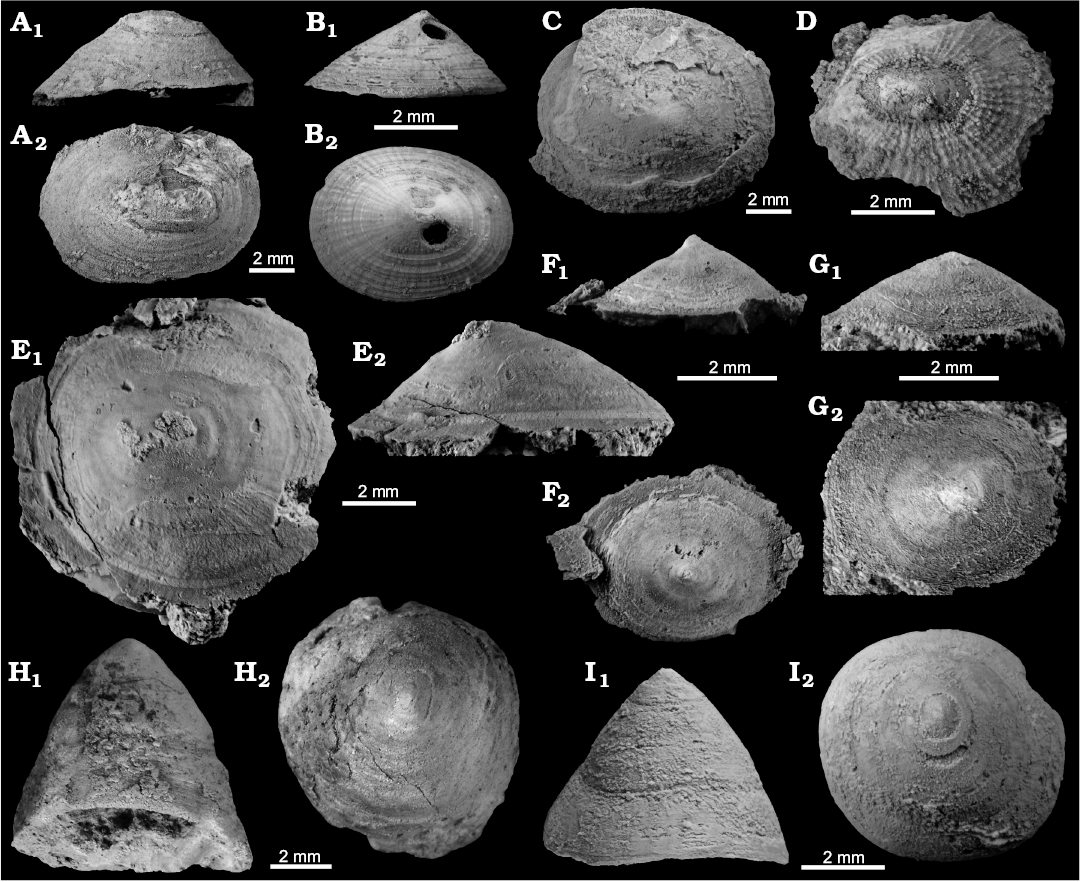
Fig. 28. Limpet gastropods from late Pliocene (A–D, E, H, I, Liog-Liog Point) and Pleistocene (F, G, Antipolo Point) seep deposit in Leyte, Philippines. A–D. Limpet gastropod sp. 1. A. NMNS PM 28427, specimen with only concentric growth increments, in lateral (A1) and apical (A2) views. B. NMNS PM 28428, specimen with fine radial ribs and a drill hole, in lateral (B1) and apical (B2) views. C. NMNS PM 28429, corroded specimen showing outline, in apical view. D. NMNS PM 28430, corroded specimen with tuberculate radial sculpture, in apical view. E. NMNS PM 28432, limpet gastropod sp. 2, in apical (E1) and lateral (E2) views, note subparallel muscle attachment scars. F, G. Limpet gastropod sp. 3, both specimens in lateral (F1, G1) and apical (F2, G2) views. F. PNMNS PM 28433, small specimen with pointed apex. G. NMNS PM 28434, corroded specimen with convex base. H, I. Limpet gastropod sp. 4, two specimens, in lateral (H1, I1) and apical (H2, I2) views. H. NMNS PM. I. NMNS PM 28426.
Subclass Neomphaliones Bouchet, Rocroi, Hausdorf, Kaim, Kano, Nützel, Parkhaev, Schrödl, and Strong, 2017
Family Neomphalidae McLean, 1981
Genus Retiskenea Warén and Bouchet, 2001
Type species: Retiskenea diploura Warén and Bouchet, 2001, by original designation; Recent, off Oregon.
Retiskenea? sp.
Fig. 29A–C.
Material.—Three specimens from the Pliocene of Liog-Liog Point (NMNS PM 28435–28437).
Dimensions (in mm).—NMNS PM 28435, W = 4.8, H = 3.9.
Remarks.—The specimens from Liog-Liog Point have a lower spire than the extant R. diploura, than the Eocene–Oligocene R. statura (Goedert and Benham, 1999) from Washington state (Goedert and Benham 1999), and also than the early Oligocene Retiskenea? sp. from northern Peru (Kiel et al. 2020). Most similar is the Cretaceous R.? tuberculata Campbell, Peterson, Alfaro, 2008 from California (Campbell et al. 2008).
Genus Planorbidella Warén and Bouchet, 1993
Type species: Depressigyra planispira Warén and Bouchet, 1989, by original designation; Recent, hydrothermal vents on the East Pacific Rise.
Planorbidella? sp.
Fig. 29D.
Material.—Three specimens from the Pliocene of Liog-Liog Point (NMNS PM 28438–28440) and one specimen (NMNS PM 28117) from the Pleistocene of Cambantug Point.
Dimensions (in mm).—NMNS PM 28438, W = 2.9, H = 1.3.
Remarks.—Shells of the heterobranch genera Hyalogyra and Hyalogyrina are quite similar, but the “archaegastropod”-type protoconch (Fig. 29D3) makes affinities with the neomphaline Planorbidella more likely. However, the protoconch lacks the irregular net sculpture typical for Planorbidella, but this might be an artefact of preservation.
Subclass Vetigastropoda Salwini-Plawen, 1980
Superfamily Trochoidea Rafinesque, 1815
Family Skeneidae Clark, 1851
Genus Dillwynella Dall, 1889
Type species: Teinostoma modesta Dall, 1889, by monotypy; Recent, Gulf of Mexico.
Dillwynella sp.
Fig. 29F.
Material.—One specimen from the Pliocene of Liog-Liog Point: NMNS PM 28441, W = 4.5 mm, H = 4.0 mm.
Remarks.—Species of Dillwynella can be variable in the height of the spire, as shown for Dillwynella vitrea Hasegawa, 1997 from wood-falls in Japanese waters (Hasegawa 1997). Two species with a similar spire and a similarly narrow umbilicus as the specimen reported here are D. haptricola Marshall, 1988 living on algal holdfasts, and D. ingens Marshall, 1988 living on wood falls in New Zealand waters (Marshall 1988).
Genus Lopheliella Hoffman, Van Heugten, and Lavaleye, 2008
Type species: Lopheliella rockallensis Hoffman, Van Heugten, and Lavaleye, 2008, by original designation; Recent, Rockall Trough, NE Atlantic Ocean.
Lopheliella? sp.
Fig. 29E.
Material.—One specimen from the Pliocene of Liog-Liog Point: NMNS PM 28442 (W = 1.0 mm, H = 1.1 mm).
Remarks.—This tiny specimen resembles Lopheliella rockallensis in its overall egg-shape with rather straight-sided whorls. However, it bears a distinct ridge along the umbilical chink, which is more pronounced than in any known species of Lopheliella (Hoffman et al. 2008, 2018).
Family Solariellidae Powell, 1951
Genus Solariella Wood, 1842
Type species: Solariella maculata Wood, 1842, by monotypy; Pliocene, England.
Solariella sp.
Fig. 29G.
2005 Solariella tobaruensis Noda, 1988; Hasegawa 2005: fig. 4E.
2017 Solariella tabaruensis [sic!] Noda; Sasaki 2017: 754, pl. 26: 12.
Material.—One specimen from the Pleistocene of Antipolo Point: NMNS PM 28443 (W = 4.5 mm, H = 4.5 mm).
Remarks.—This specimen is identical to an extant shell identified as Solariella tobaruensis Noda, 1988, collected in c. 520 m depth off Omami-oshima island (Ryukyu Islands, southern Japan) and illustrated in Hasegawa (2005) and Sasaki (2017). However, the name Solariella tobaruensis is based on a Plio-Pleistocene fossil from Okinawa, Japan (Noda 1988: 33, pl. 5: 5, 6), which has a more distinct shoulder and a deeper suture than both the extant specimen just mentioned and the Philippine specimen reported here.
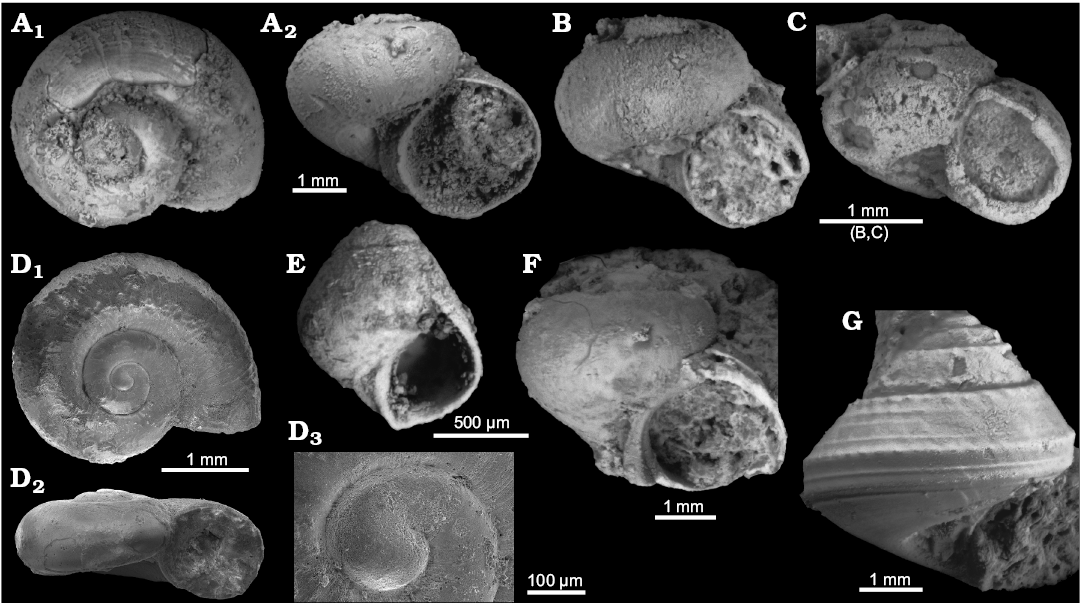
Fig. 29. Neomphaline and Vetigastopoda from late Pliocene (A–F, Liog-Liog Point) and Pleistocene (G, Antipolo Point) seep deposit in Leyte, Philippines. A–C. The neomphalid Retiskenea sp. A. NMNS PM 28435, in apical (A1) and apertural (A2) views. B. NMNS PM 28436, apertural view. C. NMNS PM 28437, apertural view. D. The neomphalid Planorbidella sp., NMNS PM 28438, in apical (D1) and apertural (D2) views, and close-up on protoconch (D3). E. Lopheliella? sp., NMNS PM 28442, apertural view, note umbilical slit bordered by distinct ridge. F. The skeneid vetigastropod Dillwynella sp., NMNS PM 28441, apical view. G. The trochoid vetigastropod Solariella sp., NMNS PM 28443, apical view.
Family Margaritidae Thiele, 1924
Genus Margarites Gray, 1847
Type species: Turbo helicinus Phipps, 1774, by original designation; Recent, North Atlantic Ocean.
Margarites hayashii sp. nov.
Fig. 30.
Zoobank LSID: urn:lsid:zoobank.org:act:24D9CA99-1B02-434F-B900- EFECAF6D8BFC
Etymology: For Hiroki Hayashi (Shimane University, Japan) who provided preliminary results of planktonic foraminifer analyses for biostratigraphy.
Type material: Holotype: NMNS PM 28444. Paratypes: NMNS PM 28445, 28446 from the type locality; all specimens with defoliated shells.
Type locality: Liog-Liog Point, Leyte, Philippines.
Type horizon: Lower Pliocene part of the Bata Formation.
Material.—Six specimens from the Pliocene of Liog-Liog Point: the type material and NMNS PM 28451 (three individuals).
Dimensions (in mm).—NMNS PM 28444, W = 17.0, H = 16.0; NMNS PM 28445, W = 12.5, H = 8.0 (specimen with most complete spire); NMNS PM 28446, W = 12.0.
Diagnosis.—Trochiform Margarites with weakly convex whorls, sculptured by six spiral cords and a finer spiral between cords; umbilicus narrow, base with fine spiral lines.
Description.—Shell trochiform, at least five whorls with convex profile, sculpture of up to six low, widely spaced cords crossed by strongly prosocline growth lines, some interspaces with fine cord; basal margin marked by another cord; base sculptured by finer and more densely spaced spiral lines than whorl flanks; umbilicus conical, width about 1/3 of shell diameter; aperture circular, strongly inclined.
Remarks.—Two similar species are Margarites shinkai Okutani, Tsuchida, and Fujikura, 1992 living around seep sites in Sagami Bay, Japan (Okutani et al. 1992; Sasaki et al. 2010) and M. similis Zhang and Zhang, 2017 from the Okinawa Trough (Zhang and Zhang 2017). The former differs from Margarites hayashii by having a more angular whorl profile, more numerous spiral cords on the whorls and narrower umbilicus. M. similis has a lower spire and more conical base than Margarites hayashii, and more densely spaced spiral cords.
Stratigraphic and geographic range.—Late Pliocene, Leyte, Philippines.
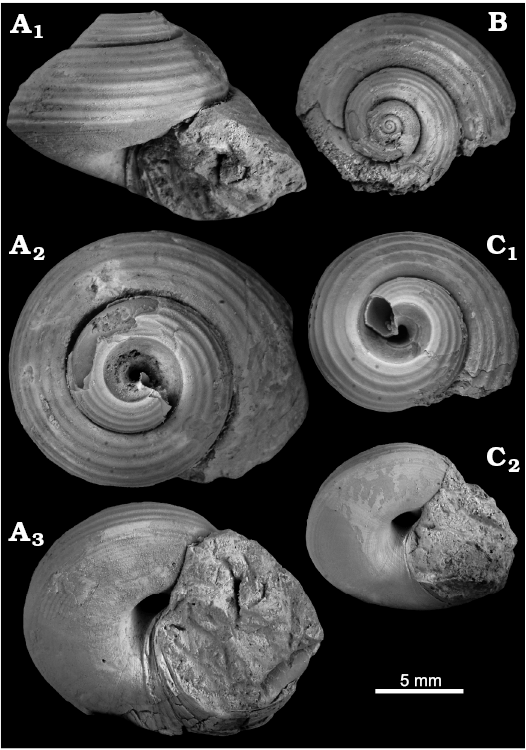
Fig. 30. The trochoid gastropod Margarites hayashii sp. nov. from the late Pliocene Liog-Liog Point seep deposit in Leyte, Philippines. A. Holotype NMNS PM 28444, in apertural (A1), apical (A2), and basal (A3) views. B. Paratype NMNS PM 28445 in apical view. C. Paratype NMNS PM 28446, in apical (C1) and basal (C2) views.
Superfamily Seguenzoidea Verrill, 1884
Family Seguenziidae Verrill, 1884
Genus Vetulonia Dall, 1913
Type species: Vetulonia galapagana Dall, 1913, by original designation; near Galapagos in deep water.
Vetulonia philippinensis sp. nov.
Fig. 31.
Zoobank LSID: urn:lsid:zoobank.org:act:D0C715F7-098E-412C-81CF-6AD3831BC53C
Etymology: In reference to its origin, the Philippines.
Holotype: NMNS PM 28447, specimen with the apertural area concealed by sediment.
Type locality: Liog-Liog Point, Leyte, Philippines.
Type horizon: Upper Pliocene part of the Bata Formation.
Material.—The holotype only.
Dimensions (in mm).—NMNS PM 28447, W = 2.5, H = 2.0.
Diagnosis.—Small turbiniform shell, 3¼ evenly convex whorls, sculpture of strongly sinuous axial ribs crossed by very fine spiral striae, umbilicus narrow.
Description.—Minute, turbiniform shell, protoconch about 0.4 mm across, teleoconch of 3¼ whorls, last whorl very large; whorls strongly convex, sculptured by ~20 very distinct, oblique axial ribs reaching into umbilical area, their interspaces about twice of rib width; ribs and interspaces crossed by ~10 very fine spiral threads.
Remarks.—Vetulonia philippinensis sp. nov. differs from the known species of Vetulonia as follows: Vetulonia galapagana is the most similar species but has fewer axial ribs per whorl (Dall 1913); Vetulonia densilirata Dall, 1927 has a flat spire according to Dall (1927: 120) in contrast to the trochiform shell of Vetulonia philippinensis; Vetulonia giacobbei Renda and Micali, 2016 has much stronger spiral ornament, giving the whorls an angular appearance; Vetulonia parajeffreysi Absalão and Pimenta, 2005 has a lower spire, and fewer and more oblique axial ribs; and Vetulonia phalcata Warén and Bouchet, 1993 has finer and more numerous axial ribs (Dautzenberg 1889; Dall 1927; Warén and Bouchet 1993, Absalão and Pimenta 2005; Renda and Micali 2016).
Stratigraphic and geographic range.—Late Pliocene, Leyte, Philippines.
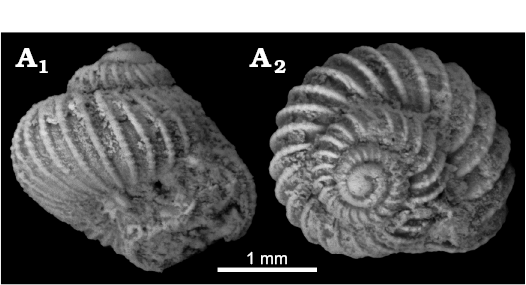
Fig. 31. The seguenzoid gastropod Vetulonia philippinensis sp. nov. from the late Pliocene seep deposit at Liog-Liog Point, Leyte, Philippines, NMNS PM 28447, apertural (A1) and apical (A2) views.
Family Cataegidae McLean and Quinn, 1987
Genus Cataegis McLean and Quinn, 1987
Type species: Cataegis toreuta McLean and Quinn, 1987, by original designation; Recent, Gulf of Mexico and Caribbean Sea.
Cataegis ramosi sp. nov.
Fig. 32.
Zoobank LSID: urn:lsid:zoobank.org:act:429B5F94-C73C-4BEA-85 A2-19EB3E311F7A
Etymology: In honour of Foracio Ramos (former director of the Philippine Mining and Geoscience Bureau Central Office) for supporting field work in the Philippines.
Type material: Holotype: NMNS PM 28448. Paratype: NMNS PM 28449 from the type locality; two complete specimens.
Type locality: Liog-Liog Point, Leyte, Philippines.
Type horizon: Upper Pliocene part of the Bata Formation.
Material.—Three specimens from the Pliocene of Liog-Liog: the type material and NMNS PM 28450 (two individuals).
Dimensions (in mm).—NMNS PM 28448, W = 18.0, H = 17.0; NMNS PM 28449, W = 18.0; H = 16.0.
Diagnosis.—Average-sized Cataegis with four distinct spiral cords per whorl, third spiral forming distinct shoulder; base with two strong spiral cords, one of them forming basal margin, and seven finer, equally strong spiral lines; aperture with apical notch, inner lip callused.
Description.—Trochiform shell with up to five whorls, suture deeply incised; whorls sculptured by four spiral cords, first two thin, closely spaced and close to upper suture, third cord strong, marking whorl’s shoulder, fourth of same strength as third, situated vertically below third close to lower suture; entire whorl surface covered by finely spaced, distinct, oblique growth increments; basal margin marked by two cords of equal strength; base rather straight with seven densely spaced, beaded spiral cords; umbilical slit covered by callus; aperture circular inclined backwards, inner lip callused with groove between umbilical and lip callus.
Remarks.—Kanoia Warén and Rouse, 2016 was separated from Cataegis based on radula characters (Warén and Rouse 2016), which are typically not preserved in fossils. Based on a comparison of the known species of Kanoia and Cataegis, the latter appears to have a higher, more conical spire whereas the spire of Kanoia appears somewhat dome-shaped (see McLean and Quinn 1987; Fu and Sun 2006, Warén and Rouse 2016; Vilvens 2016). Based on these shell characters we place C. ramosi in Cataegis rather than Kanoia.
The type species C. toreuta differs from C. ramosi by having fewer and stronger spiral cords on the base and a less distinct whorl’s shoulder (McLean and Quinn 1987). Also C. celebesensis McLean and Quinn, 1987 has fewer spiral cords on the base than C. ramosi. Cataegis leucogranulatus (Fu and Sun 2006) from the South China Sea has more granular sculpture than C. ramosi and it also has secondary, fine spiral lines between the main spiral cords, a feature not seen in C. ramosi. Among the three species of Cataegis described by Vilvens (2016) from the deep waters around the Solomon Islands, C. stroggile Vilvens, 2016 is most similar to C. ramosi but differs from it by having a more convex whorl profile with three main spiral cords instead of two, and by having fewer spiral lines on the base.
Stratigraphic and geographic range.—Late Pliocene, Leyte, Philippines.
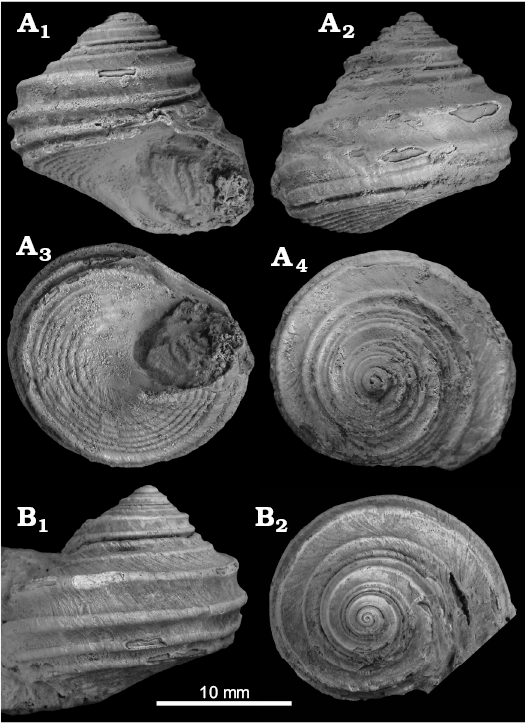
Fig. 32. The seguenzoid gastropod Cataegis ramosi sp. nov. from the late Pliocene Liog-Liog Point seep deposit in Leyte, Philippines. A. Holotype NMNS PM 28448, in apertural (A1), abapertural (A2), basal (A3), and apical (A4) views. B. Paratype NMNS PM 28449, in abapertural (B1) and apical (B2) views.
Subclass Caenogastropoda Cox, 1960
Family Provannidae Warén and Ponder, 1991
Genus Provanna Dall, 1918
Type species: Trichotropis lomana Dall, 1918, by monotypy; Recent, off California, USA.
Provanna azurini sp. nov.
Fig. 33A–C.
Zoobank LSID: urn:lsid:zoobank.org:act:F26418F1-EC73-4512-A485-35241B398A0D
Etymology: In honour of Emolyn Azurin (Philippine Mining and Geoscience Bureau, Quezon City, Philippines) for safely driving us during the field work in Leyte.
Type material: Holotype NMNS PM 28452, shell with three whorls and spiral sculpture. Paratypes: NMNS PM 28453, 28454, shells preserving few whorls and different sculptural styles from the type locality.
Type locality: Liog-Liog Point, Leyte, Philippines.
Type horizon: Upper Pliocene part of the Bata Formation.
Material.—Four specimens from the Pliocene of Liog-Liog Point: the type material and NMNS PM 28456 (six individuals, some of them fragmentary).
Dimensions (in mm).—NMNS PM 28452, H = 3.2 (at three whorls), W = 1.8. Widest available whorl fragment (unnumbered): W = 3.0.
Diagnosis.—Small for genus; tall, slender shell, whorls angular, with two equally strong spiral cords per whorl, no axial sculpture; three spiral cords of decreasing strength on base, upper one marking basal margin; aperture slightly oval.
Description.—Tall, slender shell composed of at least 3 whorls, reaching at least 4 mm in height; whorls profile angular, shoulder nearly straight and smooth, two distinct spiral cords per whorl, with broad, smooth interspace; base with three further spiral cords of decreasing strength and beaded appearance, the uppermost marks the basal margin; aperture slightly oval with small, short siphonal notch, columellar and parietal lip callused.
Remarks.—Provanna species having exclusively spiral ornament are rare. The most similar extant species are Provanna macleani Warén and Bouchet, 1989 from seeps off of Oregon, USA (Warén and Bouchet 1989), and Provanna cingulata Chen, Watanabe, and Ohara, 2018, from the Shinkai seep field in the southern Mariana Trench (Chen et al. 2018). Provanna macleani differs from Provanna azurini by having four to five spiral cords per whorl, whereas Provanna azurini has only two. Provanna cingulata has an increasing number of spiral cords per whorl, starting with two spiral cords on very early whorls. However, the whorls of Provanna cingulata are more angular and the species is overall less slender than Provanna azurini. Among fossil species, Provanna antiqua Squires, 1995 from Oligocene seeps in Washington state, USA, and northern Peru (Squires 1995; Kiel et al. 2019), has very variable sculpture including specimens with almost exclusively spiral ornament. But as in the extant P. macleani, these are more numerous (3–4) than in Provanna azurini.
Stratigraphic and geographic range.—Late Pliocene, Leyte, Philippines.
Genus Desbruyeresia Warén and Bouchet, 1993
Type species: Desbruyeresia spinosa Warén and Bouchet, 1993, by original designation; Recent, North Fiji Basin.
Desbruyeresia? sp.
Fig. 33D.
Material.—One fragment from Liog-Liog Point (NMNS PM 28457, H = 3.8 mm, W = 3.9 mm). It consists of about one convex whorl sculptured by four equally spaced spiral cords, crossed by equally strong axial ribs; the lowermost spiral cord forms the basal margin, and the base bears about five smaller cords.
Remarks.—A similar species is D. chamorrensis from South Chamorro Seamount on the southeastern Mariana Forearc (Chen et al. 2016). But with only a fragment consisting of one whorl with concealed aperture available, and similar shells known from deep-water rissoids (Warén 1996; Okutani 2000), this specimen is only hesitantly placed in Desbruyeresia.

Fig. 33. Provannid gastropods from the late Pliocene Liog-Liog Point seep deposit in Leyte, Philippines. A–C. Provanna azurini sp. nov. A. Paratype NMNS PM 28453 in apertural view. B. Paratype NMNS PM 28454 in abapertural view. C. Holotype NMNS PM 28452, specimen in apertural view with three preserved whorls but poorly preserved sculpture. D. Desbruyeresia? sp., NMNS PM 28457 in abapertural view.
Discussion
The Pliocene and Pleistocene seep faunas reported here are from four different localities, and contain a total of 30 species of chemosymbiotic bivalves and 14 species of gastropods (Table 2). 27 of these species are from the late Pliocene Liog-Liog Point site, which is a remarkably high diversity compared to other Pliocene seep faunas around the world. For comparison, there are only cursory mentions of some chemosymbiotic bivalves in Plio-Pleistocene strata the eastern Pacific region (Olsson 1942; Squires 1991; Campbell 1992), a few lucinids have been reported from Pliocene seep sites in Taiwan (Wang et al. 2006), and seven species of chemosymbiotic bivalves are known from the late Pliocene Stirone river seep complex in northern Italy (Kiel and Taviani 2018). From the well-sampled Plio-Pleistocene seep deposits around Japan, eight named vesicomyids and a few in open nomenclature are known (Amano et al. 2019), and only a few taxa of the other families of chemosymbiotic bivalves have been reported, including two solemyids (Acharax johnsoni and “Solemya sp.”), the thyasirid Conchcele bisecta, the lucinid Lucinoma acutilineata, and the mytilid Bathymodiolus sp. (Majima et al. 2005).
Table 2. The species reported here and their occurrences. * from early Pleistocene non-seep sediments at the tip of Liog-Liog Point.
|
Taxon |
Liog-Liog Point (Pliocene) |
Antipolo Point (Pleistocene) |
Buhoc Point (Pleistocene) |
Cambantug Point (Pleistocene) |
|
Bivalvia |
||||
|
Bathymodiolus securiformis Okutani, Fujikura, and Sasaki, 2004 |
× |
× |
|
|
|
Unidentified bathymodiolin |
× |
|
|
|
|
Conchocele majimai sp. nov. |
× |
|
|
|
|
Conchocele visayaensis sp. nov. |
|
|
|
× |
|
Channelaxinus antipoloensis sp. nov. |
|
× |
|
|
|
Meganodontia acetabulum Bouchet and Cosel, 2004 |
|
× |
|
|
|
Dulcina liogliogensis sp. nov. |
|
× |
× |
|
|
Dulcina magoi sp. nov. |
× |
|
× |
|
|
Elliptiolucina ingens Okutani, 2011 |
× |
|
|
|
|
Elliptiolucina fernandoi sp. nov. |
× |
|
× |
× |
|
Divalucina soyoae (Habe, 1952) |
|
|
× |
|
|
Lucinoma dulcinea Cosel and Bouchet, 2008 |
× |
× |
|
|
|
Lucinoma aff. kastoroae Cosel and Bouchet, 2008 |
× |
|
|
|
|
Lucinoma canudai sp. nov. |
|
|
|
× |
|
Lucinoma velosoi sp. nov. |
|
× |
|
× |
|
Lucinoma tinagoensis sp. nov. |
|
|
|
× |
|
Lucinoma kosatorea sp. nov. |
|
|
|
× |
|
Vesicomya margotae Beets, 1953 Pliocene |
× |
|
|
|
|
Vesicomya nakaii Okutani, 1962 |
|
|
|
× |
|
Isorropodon cf. perplexum Sturany, 1896 |
× |
|
|
× |
|
Archivesica kawamurai (Kuroda, 1943) |
|
|
|
× |
|
Archivesica pastori sp. nov. |
× |
|
|
|
|
Pliocardia kuroshimana (Okutani, Fujikura, and Kojima, 2000) |
×* |
|
|
|
|
“Pliocardia” ticaonica Dall, 1908 |
|
|
|
× |
|
“Pliocardia” indica (Prashad, 1932) |
|
|
|
× |
|
Wareniconcha guineensis (Thiele and Jaeckel, 1931) |
× |
|
|
|
|
Wareniconcha aff. winckworthi (Prashad, 1932) |
× |
|
|
|
|
Wareniconcha mercenarioides Kase, Isaji, Aguilar, and Kiel, 2019 |
× |
|
|
|
|
Waisiuconcha sp. 1 |
× |
|
|
|
|
Waisiuconcha sp. 2 |
|
|
|
× |
|
Gastropoda |
||||
|
Limpet gastropod sp. 1 |
× |
× |
|
|
|
Limpet gastropod sp. 2 |
|
× |
|
|
|
Limpet gastropod sp. 3 |
|
× |
|
|
|
Limpet gastropod sp. 4 |
× |
|
|
|
|
Retiskenea? sp. |
× |
|
|
|
|
Planorbidella? sp. |
× |
|
|
× |
|
Dillwynella sp. |
× |
|
|
|
|
Lopheliella? sp. |
× |
|
|
|
|
Solariella sp. |
|
|
|
× |
|
Margarites hayashii sp. nov. |
× |
|
|
|
|
Vetulonia philippinensis sp. nov. |
× |
|
|
|
|
Cataegis ramosi sp. nov. |
× |
|
|
|
|
Provanna azurini sp. nov. |
× |
|
|
|
|
Desbruyeresia? sp. |
× |
|
|
|
A comparison of the Leyte seep faunas to Plio-Pleistocene to Recent Japanese seep faunas is interesting. Of the five extant species from Japanese waters reported here from the late Pliocene and early Pleistocene of the Philippines (Bathymodiolus securiformis, Elliptiolucina ingens, Vesicomya nakaii, Pliocardia kuroshimana, Archivesica kawamurai), only the widespread Archivesica kawamurai has a fossil record in Japan (Amano et al. 2019). Thus it appears that a remarkable portion of the extant Japanese seep mollusks originated around the Philippines and spread to Japanese waters only recently. Furthermore, Amano et al. (2019) pointed out that the present-day distribution of vesicomyid bivalves in Japan is probably related to temperature. Whereas Calyptogena originated in colder waters and today inhabits the colder North Pacific waters of Japan, Archivesica has a warmer-water origin and today inhabits the warmer waters of southern and southeastern Japan (Amano et al. 2019). This argument could possibly be extended to a wider range of the seep fauna because all five extant Japanese taxa with a Philippine origin mentioned above presently live in areas of southern Japan influenced by the warm-water Kuroshio Current that originates around the Philippines and flows toward Japan (Saito 2019).
Another remarkable feature of the Philippine Plio-Pleistocene seep mollusks reported here is the high number of lucinids. More than one third (12 out of 30) of all bivalve species are lucinids, and nearly two thirds of the new bivalve species (7 out of 11) are lucinids. Such a large proportion of lucinids is unusual for extant seep faunas (Sibuet and Olu 1998; Sasaki et al. 2005; Olu-Le Roy et al. 2007; Cordes et al. 2010) but is more commonly seen in the fossil record. For example, in the Pliocene Stirone river seep complex, five out of seven chemosymbiotic bivalve species are lucinids (Kiel and Taviani 2018). This discrepancy might relate to the infaunal mode of life of the lucinids, due to which they are rarely found on video observations or in surface collections at modern seeps (Glover et al. 2004; Taylor and Glover 2010; Kiel 2010b).
Conclusions
We report the most diverse Plio-Pleistocene seep faunas to date; the late Pliocene Liog-Liog Point deposit alone yielded 27 species, followed by the Pleistocene Cambantug Point site (14 species) and the Antipolo Point site (9 species). Most species either belong to extant species living in the western Pacific Ocean, or are closely related to them. Remarkable is that several species occur in Japanese waters today, especially the Okinawa Trough, but those species are absent from the well-studied fossil record of seeps in Japan. The only exception is the widespread species Archivesica kawamurai, for which a warm-water origin has been suspected (Amano et al. 2019).
Acknowledgments
We would like to thank Leo L. Jasareno (Director, Mines and Geosciences Bureau, Quezon City, Philippines) for a research permit, Wenceslao Mago, Francisco Canuda, and Emolyn Azurin (all Mines and Geosciences Bureau of the Philippines, Quezon City, Philippines) for their assistance with fieldwork, and Hiroki Hayashi (Shimane University, Matsue, Japan) and Allan G.S. Fernando (The University of Philippines, Quezon City, Philippines) for microfossil analyses, and Douglas Pastor and Eduardo Veloso (both Leyte, Philippines) for allowing access and sampling on their land. We also thank Kazutaka Amano (Joetsu University of Education, Japan) for discussions and sharing images of Japanese mollusk species, Elena Krylova (P.P. Shirshov Institute of Oceanology, Moscow, Russia) for discussions on vesicomyid taxonomy, and Takuma Haga (NMNS) for help with handling specimens. Kazutaka Amano and Bruce Marshall (both Museum of New Zealand, Wellington, New Zealand) are thanked for their constructive reviews. Financial support was provided by the Swedish Science Foundation (Vetenskapsrådet) through grant 2016-03920 to SK, and by the Japan Society for the Promotion of Science through Grant-in-Aid for Scientific Research 16K05600 to TK.
References
Absalão, R.S. and Pimenta, A.D. 2005. New records and new species of Vetulonia Dall, 1913 and Brookula Iredale, 1912 from Brazil (Gastropoda: Trochidae). The Veliger 47: 193–201.
Adams, A. and Angas, G.F. 1864. Descriptions of new species of shells from the Australian seas, in the collection of George French Angas. Proceedings of the Zoological Society of London 1863: 418–428.
Amano, K. 2019. Two rare warm-water bivalves from the Pliocene Seguchi Formation in Nagano Prefecture, central Japan. Venus 78: 45–56.
Amano, K. and Jenkins, R.G. 2007. Eocene drill holes in cold-seep bivalves of Hokkaido, northern Japan. Marine Ecology 28: 108–114. Crossref
Amano, K. and Jenkins, R.G. 2011. Fossil record of extant vesicomyid species from Japan. Venus 69: 163–176.
Amano, K. and Kiel, S. 2010. Taxonomy and distribution of fossil Archivesica (Vesicomyidae, Bivalvia) in Japan. The Nautilus 124: 155–165.
Amano, K., Jenkins, R.G., Aikawa, M., and Nobuhara, T. 2010. A Miocene chemosynthetic community from the Ogaya Formation in Joetsu: evidence for depth-related ecologic control among fossil seep communities in the Japan Sea back-arc basin. Palaeogeography, Palaeoclimatology, Palaeoecology 286: 164–170. Crossref
Amano, K., Jenkins, R.G., Ohara, M., and Kiel, S. 2014. Miocene vesicomyid species (Bivalvia) from Wakayama in southern Honshu, Japan. The Nautilus 128: 9–17.
Amano, K., Little, C.T.S., and Campbell, K.A. 2018. Lucinid bivalves from Miocene hydrocarbon seep sites of eastern North Island, New Zealand, with comments on Miocene New Zealand seep faunas. Acta Palaeontologica Polonica 63: 371–382. Crossref
Amano, K., Miyajima, Y., Jenkins, R.G., and Kiel, S. 2019. The Neogene biogeographic history of vesicomyid bivalves in Japan, with two new records of the family. The Nautilus 133: 48–56.
Aoki, S. 1954. Mollusca from the Miocene Kabeya Formation, Joban coal-field, Fukushima Prefecture, Japan. Science Reports of the Tokyo Kyoiku Daigaku, Section C 17: 23–40.
Audzijonyte, A., Krylova, E.M., Sahling, H., and Vrijenhoek, R.C. 2012. Molecular taxonomy reveals broad trans-oceanic distributions and high species diversity of deep-sea clams (Bivalvia: Vesicomyidae: Pliocardiinae) in chemosynthetic environments. Systematics and Biodiversity 10: 403–415. Crossref
Beets, C. 1942. Beiträge zur Kenntnis der angeblich oberoligocänen Mollusken-Fauna der Insel Buton, Niederländisch-Ostindien. Leidsche Geologische Mededeelingen 13: 255–328.
Beets, C. 1953. Reconsideration of the so-called Oligocene fauna in the asphaltic deposits of Buton (Malay Archipelago). Leidse Geologische Mededelingen 17: 237–258.
Bellwood, D.R. and Hughes, T.P. 2001. Regional-scale assembly rules and biodiversity of coral reefs Science 292: 1532–1535. Crossref
Beu, A.G. and Maxwell, P.A. 1990. Cenozoic Mollusca of New Zealand. New Zealand Geological Survey Paleontological Bulletin 58: 1–518.
Boss, K.J. 1968. New species of Vesicomyidae from the Gulf of Darien, Caribbean Sea (Bivalvia: Mollusca). Bulletin of Marine Science 18: 731–748.
Boss, K.J. 1970. Redescription of the Valdivia Vesicomya of Thiele and Jaeckel. Mitteilungen des Zoologischen Museums in Berlin 46: 731–748. Crossref
Bouchet, P. and Cosel, R.v. 2004. The world’s largest lucinid is an undescribed species from Taiwan (Mollusca: Bivalvia). Zoological Studies 43: 704–711.
Bouchet, P., Rocroi, J.-P., Hausdorf, B., Kaim, A., Kano, Y., Nützel, A., Parkhaev, P., Schrödl, M., and Strong, E.E. 2017. Revised classification, nomenclator and typification of gastropod and monoplacophoran families. Malacologia 61: 1–526. Crossref
Campbell, K.A. 1992. Recognition of a Mio-Pliocene cold seep setting from the Northeast Pacific Convergent Margin, Washington, U.S.A. Palaios 7: 422–433. Crossref
Campbell, K.A. 2006. Hydrocarbon seep and hydrothermal vent paleoenvironments and paleontology: Past developments and future research directions. Palaeogeography, Palaeoclimatology, Palaeoecology 232: 362–407. Crossref
Campbell, K.A. and Bottjer, D.J. 1995. Brachiopods and chemosymbiotic bivalves in Phanerozoic hydrothermal vent and cold seep environments. Geology 23: 321–324. Crossref
Campbell, K.A., Nelson, C.S., Alfaro, A.C., Boyd, S., Greinert, J., Nyman, S., Grosjean, E., Logan, G.A., Gregory, M.R., Cooke, S., Linke, P., Milloy, S., and Wallis, I. 2010. Geological imprint of methane seepage on the seabed and biota of the convergent Hikurangi Margin, New Zealand: Box core and grab carbonate results. Marine Geology 272: 285–306. Crossref
Campbell, K.A., Peterson, D., and Alfaro, A.C. 2008. Two new species of Retiskenea? (Gastropoda: Neomphalidae) from Lower Cretaceous hydrocarbon seep-carbonates of northern California. Journal of Paleontology 82: 140–153. Crossref
Cau, S., Franchi, F., Roveri, M., and Taviani, M. 2015. The Pliocene-age Stirone River hydrocarbon chemoherm complex (Northern Apennines, Italy). Marine and Petroleum Geology 66: 582–595. Crossref
Chen, C., Ogura, T., Hirayama, H., Watanabe, H., Miyazaki, J., and Okutani, T. 2016. First seep-dwelling Desbruyeresia (Gastropoda: Abyssochrysoidea) species discovered from a serpentinite-hosted seep in the Southeastern Mariana Forearc. Molluscan Research 36: 277–284. Crossref
Chen, C., Watanabe, H., and Ohara, Y. 2018. A very deep Provanna (Gastropoda: Abyssochrysoidea) discovered from the Shinkai Seep Field, Southern Mariana Forearc. Journal of the Marine Biological Association of the UK 98: 439–447. Crossref
Chen, C., Watanabe, H.K., Nagai, Y., Toyofuku, T., Xu, T., Sun, J., Qiu, J.-W., and Sasaki, T. 2019. Complex factors shape phenotypic variation in deep-sea limpets. Biology Letters 15: 20190504. Crossref
Clark, W. 1851. On the classification of the British marine testaceous Mollusca. The Annals and Magazine of Natural History, Series 2 7: 469–481.
Coan, E.V., Scott, P.V., and Bernard, F.R. 2000. Bivalve Seashells of Western North America. viii + 764 pp. Santa Barbara Museum of Natural History, Santa Barbara.
Conrad, R.A. 1849. Fossils from the northwestern America. In: J.D. Dana (ed.), U.S. Exploration Expedition, 1838–1842, under Charles Wilkes. Geology, Volume 10, 723–728 (appendix). C. Sherman, Philadelphia.
Corby, G.W., Kleinpell, R.M., Popenoe, W.P., Merchant, R., William, H., Teves, J., Grey, R., Daleon, B., Mamaclay, F., Villongco, A., Herrera, M., Guillen, J., Hollister, J.S., Johnson, H.N., Billings, M.H., Fryxell, E.M., Taylor, E.F., Nelson, C.N., Birch, D.C., Reed, R.W., and Marquez, R. 1951. Geology and oil possibilities of the Philippines. Republic of the Philippines, Department of Agriculture and Natural Resources, Technical Bulletin 21: 1–363.
Cordes, E.E., Hourdez, S., and Roberts, H.H. 2010. Unusual habitats and organisms associated with the cold seeps of the Gulf of Mexico. In: S. Kiel (ed.), The Vent and Seep Biota, 315–332. Springer, Heidelberg. Crossref
Cosel, R. von and Bouchet, P. 2008. Tropical deep-water lucinids (Mollusca: Bivalvia) from the Indo-Pacific: essentially unknown, but diverse and occasionally gigantic. Tropical Deep-Sea Benthos, volume 25. Mémoires du Muséum National d’Histoire Naturelle 196: 115–213.
Cosel, R. von and Janssen, R. 2008. Bathymodioline mussels of the Bathymodiolus (s. l.) childressi clade from methane seeps near Edison Seamount, New Ireland, Papua New Guinea (Bivalvia: Mytilidae). Archiv für Molluskenkunde 137: 195–224. Crossref
Cosel, R. von and Marshall, B.A. 2003. Two new species of large mussels (Bivalvia: Mytilidae) from active submarine volcanoes and a cold seep off the eastern North Island of New Zealand, with description of a new genus. The Nautilus 117: 31–46.
Cosel, R. von and Olu, K. 2009. Large Vesicomyidae (Mollusca: Bivalvia) from cold seeps in the Gulf of Guinea off the coasts of Gabon, Congo and northern Angola. Deep-Sea Research II 56: 2350–2379. Crossref
Cosel, R. von and Salas, C. 2001. Vesicomyidae (Mollusca: Bivalvia) of the genera Vesicomya, Waisiuconcha, Isorropodon and Callogonia in the eastern Atlantic and the Mediterranean. Sarsia 86: 333–366.
Cox, L.R. 1960. Gastropoda. General characteristics of Gastropoda. In: R.C. Moore (ed.), Treatise on Invertebrate Paleontology. Pt I. Mollusca, 1, I85–I169. Geological Society of America and University of Kansas Press, Lawrence.
Cuvier, G.L.C.F.D. 1795. Second Mémoire sur l’organisation et les rapports des animaux à sang blanc, dans lequel on traite de la structure des Mollusques et de leur division en ordre, lu à la société d’Histoire Naturelle de Paris, le 11 prairial an troisième. Magazin Encyclopédique, ou Journal des Sciences, des Lettres et des Arts 2: 433–449.
Dall, W.H. 1886. Reports on the results of dredging, under the supervision of Alexander Agassiz, in the Gulf of Mexico (1877–78) and in the Caribbean Sea (1879–80), by the U.S. Coast Survey steamer “Blake” XXIX. Report on the Mollusca. Part 1, Brachiopoda and Pelecypoda. Bulletin of the Museum of Comparative Zoology, Harvard University 12: 171–318.
Dall, W.H. 1889. Reports on the results of dredging, under the supervision of Alexander Agassiz, in the Gulf of Mexico (1877–78) and in the Caribbean Sea (1879–80), by the U.S. Coast Survey steamer “Blake” XXIX. Report on the Mollusca. Part 2, Gastropoda and Scaphopoda. Bulletin of the Museum of Comparative Zoology, Harvard University 18: 1–492.
Dall, W.H. 1896. Diagnoses of new species of mollusks from the west coast of America. Proceedings of the U.S. National Museum of Natural History 18: 7–20. Crossref
Dall, W.H. 1900. Contributions to the Tertiary fauna of Florida, with especial reference to the Miocene silex-beds of Tampa and the Pliocene beds of the Caloosahatchie River. Part 5, Teleodemacea: Solen to Diplodonta. Transactions of the Wagner free Institute of Science, Philadelphia 3: 949–1218.
Dall, W.H. 1901. Synopsis of the Lucinacea and of the American species. Proceedings of the U.S. National Museum of Natural History 23: 779–833. Crossref
Dall, W.H. 1903. Contributions to the Tertiary fauna of Florida, with especial reference to the silex beds of Tampa and the Pliocene beds of the Caloosahatchie River, including in many cases a complete revision of the generic groups treated of and their American species. Part VI. Concluding the work. Wagner Free Institute of Science of Philadelphia, Transactions 3: xiv, 1219–1654. Crossref
Dall, W.H. 1908a. A gigantic Solemya and a new Vesicomya. The Nautilus 22: 61–63.
Dall, W.H. 1908b. The Mollusca and the Brachiopoda. Bulletin of the Museum of Comparative Zoology, Harvard University 43: 205–487. Crossref
Dall, W.H. 1913. A new genus of Trochidae. The Nautilus 27: 86–87.
Dall, W.H. 1918. Description of new species of shells chiefly from Magdalena Bay, Lower California. Proceedings of the Biological Society of Washington 31: 5–8.
Dall, W.H. 1927. Small shells from dredgings off the southeast coast of the United States by the United States fisheries steamer “Albatross” in 1885 and 1886. Proceedings of the U.S. National Museum of Natural History 70: 1–134. Crossref
Dall, W.H. and Simpson, C.T. 1901. The Mollusca of Porto Rico. United States Fishery Commission, Bulletin 20: 351–524.
Dautzenberg, P. 1889. Contribution à la faune malacologique des Iles Açores. Résultats des Campagnes Scientifiques Accomplies sur son Yacht par Albert Ier Prince Souverain de Monaco. 112 pp. Imprimerie de Monaco, Monaco.
Dekker, H. and Goud, J. 1994. Review of the living Indo-West-Pacific species of Divaricella sensu auct. with descriptions of two new species and a summary of the species from other regions (Part 2). Vita Marina 43: 1–12.
Ellison, A.M., Farnsworth, E.J., and Merkt, R.E. 1999. Origins of mangrove ecosystems and the mangrove biodiversity anomaly. Global Ecology and Biogeography 8: 95–115. Crossref
Fleming, J. 1828. A History of British Animals, Exhibiting the Descriptive Characters and Systematical Arrangement of the Genera and Species of Quadrupeds, Birds, Reptiles, Fishes, Mollusca and Radiata of the United Kingdom; Including the Indigenous, Extirpated, and Extinct Kinds; Together with Periodical and Occasional Visitants. xxiii + 554 pp. Bell & Bradfute, Edinburgh. Crossref
Fu, I.-F. and Sun, C.-L. 2006. A new bathyal trochid from South China Sea. Bulletin of Malacology, Taiwan 30: 17–20.
Gabb, W.M. 1866–1869. Cretaceous and Tertiary fossils. California Geological Survey, Paleontology 2: 1–299.
Glover, E.A. and Taylor, J.D. 2016. Lucinidae of the Philippines: highest known diversity and ubiquity of chemosymbiotic bivalves from intertidal to bathyal depths (Mollusca: Bivalvia: Lucinidae). Mémoires du Muséum National d’Histoire Naturelle 208: 65–234.
Glover, E.A., Taylor, J.D., and Rowden, A.A. 2004. Bathyaustriella thionipta, a new lucinid bivalve from a hydrothermal vent on the Kermadec Ridge, New Zealand and its relationship to shallow-water taxa (Bivalvia: Lucinidae). Journal of Molluscan Studies 70: 283–295. Crossref
Goedert, J.L. and Benham, S.R. 1999. A new species of Depressigyra? (Gastropoda: Peltospiridae) from cold-seep carbonates in Eocene and Oligocene rocks of western Washington. The Veliger 42: 112–116.
Gray, J.E. 1847. A list of the genera of Recent Mollusca, their synonyma and types. Proceedings of the Zoological Record of London 15: 129–219.
Habe, T. 1952. Lyonsiidae, Poromyidae, Arcticidae, and Gaimardiidae in Japan. III. Catalogue of Japanese Shells 1: 153–160.
Habe, T. 1958. Report on the Mollusca chiefly collected by the S.S. Soyo-Maru of the Imperial Fisheries Experimental Station on the continental shelf bordering Japan during the years 1922–1930 . Part 3. Lamellibranchia (1) 3. Publications of Seto Marine Biological Laboratory, Kyoto University 6: 241–280. Crossref
Habe, T. 1976a. Eight new bivalves from Japan. Venus 35: 37–46.
Habe, T. 1976b. New and little known bivalves of Japan. Venus 36: 1–13.
Habe, T. 1981. A catalogue of molluscs of Wakayama Prefecture, the province of Kii. Bivalvia, Scaphopoda and Cephalopoda. Publications of the Seto Marine Biological Laboratory. Special Publication Series 7: i–xiii + 1–264. Crossref
Hasegawa, K. 2005. A preliminary list of deep-sea gastropods collected from the Nansei Islands, southwestern Japan. National Science Museum Monographs 29: 137–190.
Hasegawa, T. 1997. Sunken wood-associated gastropods collected from Suruga Bay, Pacific side of the Central Honshu, Japan, with descriptions of 12 new species. National Science Museum Monographs 12: 59–123.
Hashimoto, J. and Okutani, T. 1994. Four new mytilid mussels associated with deepsea chemosynthetic communities around Japan. Venus 53: 61–83.
Haszprunar, G. 1987. Anatomy and affinities of cocculinid limpets (Mollusca Archaeogastropoda). Zoologica Scripta 16: 305–324. Crossref
Higo, S., Callomon, P., and Goto, Y. 1999. Catalogue and Bibliography of the Marine Shell-Bearing Mollusca of Japan. 749 pp. Elle Scientific Publications, Osaka.
Hirayama, K. 1954. On some Miocene species of Lucinoma from Japan, with description of two new species. Japanese Journal of Geology and Geography 25: 101–115.
Hirayama, K. 1958. On Lucinoma aokii. A new Pleistocene lamellibranch from Chiba Prefecture, Japan. Transactions and Proceedings of the Paleontological Society of Japan. New series 1958: 231–236.
Hoffman, L., Cosel, R. von, and Freiwald, A. 2019. New and little-known Pliocardiinae (Bivalvia, Vesicomyidae) from the continental slope off Mauritania. Basteria 83: 151–157.
Hoffman, L., Freiwald, A., Van Heugten, B., and Lavaleye, M.S.S. 2018. New information on Ganesa, Lopheliella and Trochaclis (Gastropoda) in deep-water coral habitats in the North Atlantic. Miscellanea Malacologica 8: 27–34.
Hoffman, L., Van Heugten, B., and Lavaleye, M.S.S. 2008. A new genus with four new species in the family Skeneidae (Gastropoda) from the Rockall Bank, northeastern Atlantic Ocean. Miscellanea Malacologica 3: 39–48.
Holmes, A.M., Oliver, P.G., and Sellanes, J. 2005. A new species of Lucinoma (Bivalvia: Lucinoidea) from a methane gas seep off the southwest coast of Chile. Journal of Conchology 38: 673–681.
Huang, C.-Y., Yuan, P.B., and Tsao, S.-J. 2006. Temporal and spatial records of active arc-continent collision in Taiwan: A synthesis. Geological Society of America Bulletin 118: 274–288. Crossref
Huber, M. 2010. Compendium of Bivalves. 901 pp. Conch Books, Hackenheim.
Iredale, T. 1930. More notes on the marine Mollusca of New South Wales. Records of the Australian Museum 17: 384–407. Crossref
Iredale, T. 1936. Australian molluscan notes, No. 2. Records of the Australian Museum 19: 267–340. Crossref
Ishizaki, K. 1942. A new late Tertiary species of Thyasira from southern Formosa. Transactions of the Natural History Society of Formosa 32: 345–352.
Itoigawa, J. 1960. Paleoecological studies of the Miocene Mizunami group, central Japan. Journal of Earth Sciences, Nagoya University 8: 246–300.
Jablonski, D., Roy, K., and Valentine, D.L. 2006. Out of the tropics: Evolutionary dynamics of the latitudinal diversity gradient. Science 314: 102–106. Crossref
Janssen, A.W. 1999. Euthecosomatous gastropods (Mollusca: Heterobranchia) from Buton (SE Sulawesi, Indonesia), with notes on species from Viti Levu, Fiji; systematics, biostratigraphy. Geologie en Mijnbouw 78: 179–189. Crossref
Jenkins, R.G., Kaim, A., and Hikida, Y. 2007. Antiquity of the substrate choice among acmaeid limpets from the Late Cretaceous chemosynthesis-based communities. Acta Palaeontologica Polonica 52: 369–373.
Johnson, S.B., Krylova, E.M., Audzijonyte, A., Sahling, H., and Vrijenhoek, R.C. 2017. Phylogeny and origins of chemosynthetic vesicomyid clams. Systematics and Biodiversity 15: 346–360. Crossref
Kamenev, G.M., Nadtochy, V.A., and Kuznetsov, A.P. 2001. Conchocele bisecta (Conrad, 1849) (Bivalvia: Thyasiridae) from cold-water methane-rich areas of the Sea of Okhotsk. The Veliger 44: 84–94.
Kase, T., Isaji, S., Aguilar, Y.M., and Kiel, S. 2019. A large new Wareniconcha (Bivalvia: Vesicomyidae) from a Pliocene methane seep deposit in Leyte, Philippines. The Nautilus 133: 26–30.
Kenk, V.C. and Wilson, B.R. 1985. A new mussel (Bivalvia: Mytilidae) from hydrothermal vents in the Galapagos Rift Zone. Malacologia 26: 253–271.
Kharlamenko, V.I., Kamenev, G.M., Kalachev, A.V., Kiyashko, S.I., and Ivin, V.V. 2016. Thyasirid bivalves from the methane seep community off Paramushir Island (Sea of Okhotsk) and their nutrition. Journal of Molluscan Studies 82: 391–402. Crossref
Kiel, S. 2010a. On the potential generality of depth-related ecologic structure in cold-seep communities: Cenozoic and Mesozoic examples. Palaeogeography, Palaeoclimatology, Palaeoecology 295: 245–257. Crossref
Kiel, S. 2010ba. The fossil record of vent and seep mollusks. In: S. Kiel (ed.), The Vent and Seep Biota, 255–278. Springer, Heidelberg. Crossref
Kiel, S. 2013. Lucinid bivalves from ancient methane seeps. Journal of Molluscan Studies 79: 346–363. Crossref
Kiel, S. 2015. Did shifting seawater sulfate concentrations drive the evolution of deep-sea vent and seep ecosystems? Proceedings of the Royal Society B 282: 20142908. Crossref
Kiel, S., Altamirano, A.J., Birgel, D., Coxall, H.K., Hybertsen, F., and Peckmann, J. 2019. Fossiliferous methane-seep deposits from the Cenozoic Talara Basin in northern Peru. Lethaia 53: 166–182. Crossref
Kiel, S., Amano, K., and Jenkins, R.G. 2016. Predation scar frequencies in chemosymbiotic bivalves at an Oligocene seep deposit and their potential relation to inferred sulfide tolerances. Palaeogeography, Palaeoclimatology, Palaeoecology 453: 139–145. Crossref
Kiel, S., Hybertsen, F., Hyžný, M., and Klompmaker, A.A. 2020. Mollusks and a crustacean from early Oligocene methane-seep deposits in the Talara Basin, northern Peru. Acta Palaeontologica Polonica 65: 109–138. Crossref
Kiel, S. and Taviani, M. 2017. Chemosymbiotic bivalves from Miocene methane-seep carbonates in Italy. Journal of Paleontology 91: 444–466. Crossref
Kiel, S. and Taviani, M. 2018. Chemosymbiotic bivalves from the late Pliocene Stirone River hydrocarbon seep complex in northern Italy. Acta Palaeontologica Polonica 63: 557–568. Crossref
Krishtofovich, L.V. 1936. Shells of the group Thyasira bisecta (Conrad) from the Tertiary deposits of the west coast of Kamchatka [in Russian]. Trudy Neftânogo-Razvedočnogo Instituta, Seriâ A 88: 3–67.
Krylova, E.M. and Sahling, H. 2006. Recent bivalve molluscs of the genus Calyptogena (Vesicomyidae). Journal of Molluscan Studies 72: 359–395. Crossref
Krylova, E.M. and Sahling, H. 2010. Vesicomyidae (Bivalvia): current taxonomy and distribution. PLoS ONE 5: e9957. Crossref
Kuo, M.-Y., Kang, D.-R., Chang, C.-H., Chao, C.-H., Wang, C.-C., Chen, H.-H., Su, C.-C., Chen, H.-W., Lai, M.-C., Lin, S., and Liu, L.-L. 2019. New records of three deep-sea Bathymodiolus mussels (Bivalvia: Mytilida: Mytilidae) from hydrothermal vents and cold seeps in Taiwan. Journal of Marine Science and Technology 27: 352-358.
Kuroda, T. 1943. Akebiconcha, a new pelecypod genus. Venus 13: 14–18.
Kuroda, T. 1952. On Callocardia guttata A. Adams and Vesicomya katsuae, n. sp. [in Japanese]. Venus 17: 1–5.
Lamarck, J.B.P.A.d.M.d. 1818. Histoire naturelle des animaux sans vertèbres... Tome 5. 612 pp. Verdière, Paris.
Linnaeus, C. 1758. Systema naturæ per regna tria naturæ, secundum classes, ordines, genera, species, cum characteribus, differentiis, synonymis, locis. Tomus I. Editio decima, reformata. 824 pp. Salvius, Holmiae. Crossref
Lorion, J., Buge, B., Cruaud, C., and Samadi, S. 2010. New insights into diversity and evolution of deep-sea Mytilidae (Mollusca: Bivalvia). Molecular Phylogenetics and Evolution 57: 71–83. Crossref
Majima, R., Jenkins, R.G., Kase, T., Aguilar, Y.M., Nanjo, T., Wani, R., Wada, H., Fernando, A.G.S., and Hayashi, H. 2010. In situ Calyptogena colonies from Pliocene back-arc basin fills in Leyte Island, Philippines. Journal of the Geological Society of Japan 116: 15–16. Crossref
Majima, R., Kase, T., Kawagata, S., Aguilar, Y.M., Hagino, K., and Maeda, M. 2007. Fossil cold-seep assemblages from Leyte Island, Philippines. Journal of Geography 116: 643–652. Crossref
Majima, R., Nobuhara, T., and Kitazaki, T. 2005. Review of fossil chemosynthetic assemblages in Japan. Palaeogeography, Palaeoclimatology, Palaeoecology 227: 86–123. Crossref
Marshall, B.A. 1985. Recent and Tertiary deep-sea limpets of the genus Pectinodonta Dall (Mollusca: Gastropoda) from New Zealand and New South Wales. New Zealand Journal of Zoology 12: 273–282. Crossref
Marshall, B.A. 1986. Recent and Tertiary Cocculinidae and Pseudococculinidae (Mollusca: Gastropoda) from New Zealand and New South Wales. New Zealand Journal of Zoology 12: 505–546. Crossref
Marshall, B.A. 1988. Skeneidae, Vitrinellidae and Orbitestellidae (Mollusca: Gastropoda) associated with biogenic substrata from bathyal depths off New Zealand and New South Wales. Journal of Natural History 22: 949–1004. Crossref
Marshall, B.A. 1998. A new deep-sea limpet of the genus Pectinodonta Dall, 1882 from New Zealand, and new distribution records for P. aupouria and P. morioria Marshall, 1985 (Gastropoda: Acmaeidae). The Nautilus 112: 52–57.
Marshall, B.A., Puillandre, N., Lambourdiere, J., Couloux, A., and Samadi, S. 2016. Deep-sea wood-eating limpets of the genus Pectinodonta Dall, 1882 (Mollusca: Gastropoda: Patellogastropoda: Pectinodontidae) from the tropical West Pacific. Mémoires du Muséum National d‘Histoire Naturelle 208: 235–265.
Martin, K. 1933. Eine neue tertiäre Molluskenfauna aus dem indischen Archipel. Leidsche Geologische Mededeelingen 6: 7–32.
Marwick, J. 1953. A Pliocene fossil found living by the Galathea Expedition. New Zealand Journal of Science and Technology (B) 35: 109–112.
McLean, J.H. 1981. The Galapagos Rift limpet Neomphalus: Relevance to understanding the evolution of a major Paleozoic–Mesozoic radiation. Malacologia 21: 291–336.
McLean, J.H. 1990. Neolepetopsidae, a new docoglossate limpet family from hydrothermal vents and its relevance to patellogastropod evolution. Journal of Zoology 222: 485–528. Crossref
McLean, J.H. 2008. Three new species of the family Neolepetopsidae (Patellogastropoda) from hydrothermal vents and whale falls in the northeastern Pacific. Journal of Shellfish Research 27: 15–20. Crossref
McLean, J.H. and Harasewych, M.G. 1995. Review of western Atlantic species of cocculinid and pseudococculinid limpets, with descriptions of new species (Gastropoda: Cocculiniformia). Contributions in Science, Natural History Museum of Los Angeles County 453: 1–33.
McLean, J.H. and Quinn, J.F.J. 1987. Cataegis, new genus of three new species from the continental slope (Trochidae: Cataeginae new subfamily). The Nautilus 101: 111–116. Crossref
Miyajima, Y., Nobuhara, T., and Koike, H. 2017. Taxonomic reexamination of three vesicomyid species (Bivalvia) from the middle Miocene Bessho Formation in Nagao Prefecture, central Japan, with notes on vesicomyid diversity. The Nautilus 131: 51–66.
Noda, H. 1988. Molluscan fossils from the Ryukyu Islands, southwest Japan Part 2. Gastropoda and Pelecypoda from the Shinzato Formation in the middle part of Okinawa-jima. Science Reports of the Institute of Geoscience University of Tsukuba Section B=Geological Sciences 9: 29–85.
Okutani, T. 1962. Report on the archibenthal and abyssal Lamellibranchiate Mollusca mainly collected from Sagami Bay and adjacent waters by the RV Soyo-Maru during the years 1955–1960. Contributions from the Tokai Regional Fisheries Research Laboratory 160: 1–40.
Okutani, T. 2000. Marine Mollusks in Japan. 1173 pp. Tokai University Press, Tokyo.
Okutani, T. 2002. A new thyasirid Conchocele novaeguinensis n. sp. from a thanatocoenosis associated with a possible cold seep activity off New Guinea. Venus 61: 141–145.
Okutani, T. 2011. Bizarre lucinid bivalves from southwestern Japan, including a new species, and relatives in adjacent waters. Venus 69: 115–122.
Okutani, T. and Hashimoto, J. 1997. A new species of lucinid bivalve (Heterodonta: Lucinidae) from Kanesu-no-Se Bank near the Mouth of Suruga Bay, with a review of the recent species of the chemosynthetic genus Lucinoma from Japan. Venus 56: 271–280.
Okutani, T., Fujikura, K., and Kojima, S. 2000. New taxa and review of vesicomyid bivalves collected from the Northwest Pacific by deep sea research systems of Japan Marine Science & Technology Center. Venus 59: 83–101.
Okutani, T., Fujikura, K., and Sasaki, T. 2004. Two new species of Bathymodiolus (Bivalvia: Mytilidae) from methane seeps on the Kuroshima Knoll off the Yaeyama Island, southwestern Japan. Venus 62: 97–110.
Okutani, T., Kojima, S., and Ashi, J. 1997. Further discovery of a new taxon of vesicomyid clam from the Nankai Trough, off Honshu, Japan. Venus 56: 185–188.
Okutani, T., Kojima, S., and Iwasaki, N. 2002. New and known vesicomyid bivalves recently collected from the western and central Nankai Trough off Shikoku and Honshu, by Deep Sea Research Systems of Japan Marine Science and Technology Center. Venus 61: 129–140.
Okutani, T., Tsuchida, S., and Fujikura, K. 1992. Five bathyal gastropods living within or near the Calyptogena-community of the Hatsushima Islet, Sagami Bay. Venus 51: 137–148.
Oliver, P.G. 2015. Deep-water Thyasiridae (Mollusca: Bivalvia) from the Oman Margin, Arabian Sea, new species and examples of endemism and cosmopolitanism. Zootaxa 3995: 252–263. Crossref
Oliver, P.G. and Frey, M.A. 2014. Ascetoaxinus quatsinoensis sp. et gen. nov. (Bivalvia: Thyasiroidea) from Vancouver Island, with notes on Conchocele Gabb, 1866, and Channelaxinus Valentich-Scott & Coan, 2012. Zootaxa 3869: 452–468.Crossref
Olsson, A.A. 1942. Tertiary and Quaternary fossils from the Burica Peninsula of Panama and Costa Rica. Bulletins of American Paleontology 27: 1–106.
Olu-Le Roy, K., Caprais, J.-C., Fifis, A., Fabri, M.-C., Galéron, J., Budzinsky, H., Le Ménach, K., Khripounoff, A., Ondréas, H., and Sibuet, M. 2007. Cold-seep assemblages on a giant pockmark off West Africa: spatial patterns and environmental control. Marine Ecology 28: 115–130. Crossref
Omori, M. 1954. Conchocele compacta Ishizaki and its subspecies minor from the Tertiary of Japan. Science Reports of the Tokyo Kyoiku Daigaku, Section C 3: 87–97.
Oppo, D., De Siena, L., and Kemp, D.B. 2020. A record of seafloor methane seepage across the last 150 million years. Scientific Reports 10: 2562. Crossref
Phipps, C.J. 1774. A voyage towards the North Pole undertaken by His Majesty’s command 1773. pp. W. Bowyer and J. Nichols, London.
Porth, H., Müller, C., and von Daniel, C.H. 1989. The sedimentary formations of the Visayan Basin, Philippines. Geologisches Jahrbuch B70: 29–87.
Powell, A.B.W. 1935. Tertiary Mollusca from Motutara, West Coast, Auckland. Records of the Auckland Institute and Museum 1: 327–340.
Powell, A.B.W. 1951. Antarctic and subantarctic Mollusca: Pelecypoda and Gastropoda. Discovery Reports 26: 47–196. Crossref
Prashad, B. 1932. The Lamellibranchia of the Siboga expedition. Systematic part II (exclusive of the Pectinidae). Siboga Expeditie 53c: 1–351.
Rafinesque, C.S. 1815. Analyse de la nature, ou Tableau de l’univers et des corps organisées. 224 pp. Barraveccia, Palermo. Crossref
Renda, W. and Micali, P. 2016. Vetulonia giacobbei n. sp. from south Tyrrhenian Sea (Gastropoda, Seguenzioidea). Bolletino Malacologico 52: 56–59.
Renema, W., Bellwood, D.R., Braga, J.C., Bromfield, K., Hall, R., Johnson, K.G., Lunt, P., Meyer, C.P., McMonagle, L.B., Morley, R.J., O’Dea, A., Todd, J.A., Wesselingh, F.P., Wilson, M.E.J., and Pandolfi, J.M. 2008. Hopping Hotspots: Global shifts in marine biodiversity. Science 321: 654–657. Crossref
Saito, H. 2019. The Kuroshio: Its recognition, scientific activities and emerging issues. In: T. Nagai, H. Saito, K. Suzuki, and M. Takahashi (eds.), Kuroshio Current: Physical, Biogeochemical, and Ecosystem Dynamics, Geophysical Monograph 243, 1–11. John Wiley & Sons, Washington, DC. Crossref
Salvini-Plawen, L. 1980. A reconsideration of systematics in the Mollusca (phylogeny and higher classification). Malacologia 19: 249–278.
Samadi, S., Puillandre, N., Pante, E., Boisselier, M.-C., Chen, W.-J., Corbari, L., Maestrati, P., Mana, R., Thubaut, J., Zuccon, D., and Hourdez, S. 2015. Patchiness of deep-sea communities in Papua New Guinea and potential susceptibility to anthropogenic disturbances illustrated by seep organisms. Marine Ecology 36 (Supplement 1): 109–132. Crossref
Sasaki, T. 2017. Family Solariellidae. In: T. Okutani (ed.), Marine Mollusks in Japan, 2nd edition, 70–71 (atlas) + 754–755 (text). Tokai University Press, Hiratsuka, Kanagawa.
Sasaki, T., Okutani, T., and Fujikura, K. 2005. Molluscs from hydrothermal vents and cold seeps in Japan: A review of taxa recorded in twenty recent years. Venus 64: 87–133.
Sasaki, T., Warén, A., Kano, Y., Okutani, T., and Fujikura, K. 2010. Gastropods from Recent hot vents and cold seeps: systematics, diversity and life strategies. In: S. Kiel (ed.), The Vent and Seep Biota, 169–254. Springer, Heidelberg. Crossref
Scarlato, O.A. 1981. Dvustvorčatye mollûski umerennyx širot zapadnoj časti Tixogo okeana. 479 pp. Institut zoologii, Akademiâ Nauk SSSR, Moskva.
Shibasaki, T. and Majima, R. 1997. A fossil chemosynthetic community from outer shelf environment of the Middle Pleistocene Kakinokidai Formation, Kazusa Group in Boso Peninsula, Chiba Prefecture, central Japan. Journal of the Geological Society of Japan 103: 1065–1080. Crossref
Sibuet, M. and Olu, K. 1998. Biogeography, biodiversity and fluid dependence of deep-sea cold-seep communities at active and passive margins. Deep-Sea Research II 45: 517–567. Crossref
Smith, E.A. 1885. Report on the Lamellibranchiata collected by H.M.S. Challenger during the years 1873–1876. Reports of the Scientific Results of the Challenger Expedition, Zoology 13: 1–341.
Smith, E.A. 1904. Natural history notes from H.M. Indian Marine Survey steamer “Investigator”, Commander T.H. Heming, R.N., Series III., No. 1. On Mollusca from the Bengal and the Arabian Sea. Annals and Magazine of Natural History 14: 1–14. Crossref
Squires, R.L. 1991. New morphologic and stratigraphic information on Calyptogena (Calyptogena) gibbera Crickmay, 1929, (Bivalvia: Vesicomyidae), from the Pliocene and Pleistocene of southern California. The Veliger 34: 73–77.
Squires, R.L. 1995. First fossil species of the chemosynthetic-community gastropod Provanna: Localized cold-seep limestones in Upper Eocene and Oligocene rocks, Washington. The Veliger 38: 30–36.
Stimpson, W. 1851. A Revision of the Synonymy of the Testaceous Mollusks of New England, with Notes on Their Structure, and Their Geographical and Bathymetrical Distribution. 58 pp. Phillips, Sampson, and company, Boston. Crossref
Sturany, R. 1896. Mollusken I (Prosobranchier und Opisthobranchier; Scaphopoden; Lamellibranchier) gesammelt von S.M. Schiff “Pola” 1890–94. Denkschriften der mathematisch-naturwissenschaftlichen Klasse der Kaiserlichen Akademie der Wissenschaften 63: 1–36.
Taylor, J.D. and Glover, E.A. 2006. Lucinidae (Bivalvia)—the most diverse group of chemosymbiotic molluscs. Zoological Journal of the Linnean Society 148: 421–438. Crossref
Taylor, J.D. and Glover, E.A. 2010. Chemosymbiotic bivalves. In: S. Kiel (ed.), The Vent and Seep Biota, 107–136. Springer, Heidelberg. Crossref
Taylor, J.D., Glover, E.A., and Williams, S.T. 2014. Diversification of chemosymbiotic bivalves: origins and relationships of deeper water Lucinidae. Biological Journal of the Linnean Society 11: 401–420. Crossref
Thiele, J. 1924. Revision des Systems der Trochacea. Mitteilungen aus dem Zoologischen Museum in Berlin 11: 47–74. Crossref
Thiele, J. and Jaeckel, S. 1931. Muscheln der Deutschen Tiefsee-Expedition. II Teil. Deutsche Tiefsee-Expedition 1898–1899 21: 159–268.
Valdés, F., Sellanes, J., and D‘Elía, G. 2013. Phylogenetic position of vesicomyid clams from a methane seep off central Chile (~36°S) with a molecular timescale for the diversification of the Vesicomyidae. Zoological Studies 51: 1154–1164.
Verrill, A.E. 1884. Second catalogue of Mollusca recently added to the fauna of the New England Coast and the adjacent part of the Atlantic, consisting mostly of deep sea species, with notes on others previously recorded. Transactions of the Connecticut Academy of Science 6: 139–294. Crossref
Vilvens, C. 2016. New records and new species of Cataegis (Gastropoda: Seguenzioidea) from Solomon Islands. Novapex 17: 67–76.
Wang, S.-W., Gong, S.-Y., Mii, H.-S., and Dai, C.-F. 2006. Cold-seep carbonate hardgrounds as the initial substrata of coral reef development in a siliciclastic paleoenvironment of southwestern Taiwan. Terrestrial, Atmospheric & Oceanic Sciences 17: 405–427. Crossref
Warén, A. 1996. New and little known Mollusca from Iceland and Scandinavia, Part 3. Sarsia 81: 197–245. Crossref
Warén, A. and Bouchet, P. 1989. New gastropods from East Pacific hydrothermal vents. Zoologica Scripta 18: 67–102. Crossref
Warén, A. and Bouchet, P. 1993. New records, species, genera, and a new family of gastropods from hydrothermal vents and hydrocarbon seeps. Zoologica Scripta 22: 1–90. Crossref
Warén, A. and Bouchet, P. 2001. Gastropoda and Monoplacophora from hydrothermal vents and seeps; new taxa and records. The Veliger 44: 116–231.
Warén, A. and Bouchet, P. 2009. New gastropods from deep-sea hydrocarbon seeps off West Africa. Deep-Sea Research I 56: 2326–2349. Crossref
Warén, A. and Ponder, W.F. 1991. New species, anatomy, and systematic position of the hydrothermal vent and hydrocarbon seep gastropod family Provannidae fam. n. (Caenogastropoda). Zoologica Scripta 20: 56–102. Crossref
Warén, A. and Rouse, G.W. 2016. A new genus and species of Cataegidae (Gastropoda: Seguenzioidea) from eastern Pacific Ocean methane seeps. Novapex 17: 59–66.
Wood, S.V. 1842. A catalog of shells from the Crag. Annals and Magazine of Natural History, Series 1 9: 455–461, 527–544. Crossref
Woodring, W.P. 1925. Miocene Mollusca from Bowden Jamaica, pelecypods and scaphopods. Carnegie Institution of Washington publications 336: 1–564.
Zhang, S. and Zhang, S. 2017. Two new species of Margarites (Gastropoda: Margaritidae) from hydrothermal vent areas, Western Pacific. Zootaxa 4299: 441–450. Crossref
Zhang, S. and Zhang, S. 2018. A new species of the genus Pectinodonta Dall, 1882 (Gastropoda: Pectinodontidae) from the East China Sea. Molluscan Research 38: 86–89. Crossref
Acta Palaeontol. Pol. 65 (3): 589–627,
2020 https://doi.org/10.4202/app.00756.2020